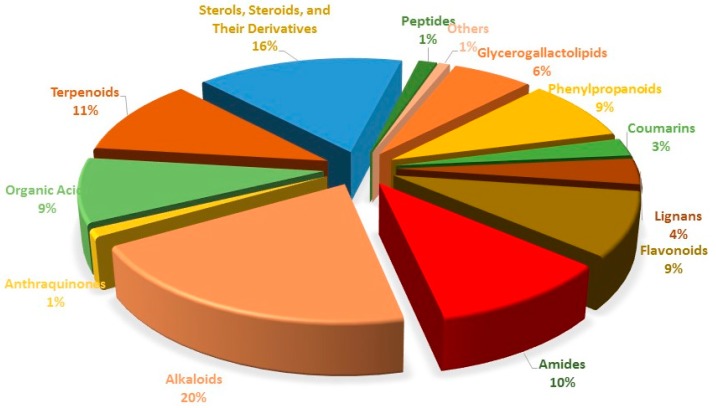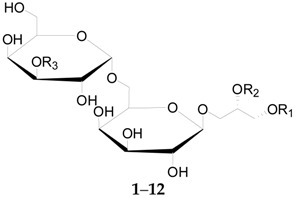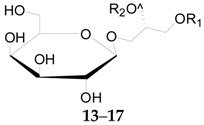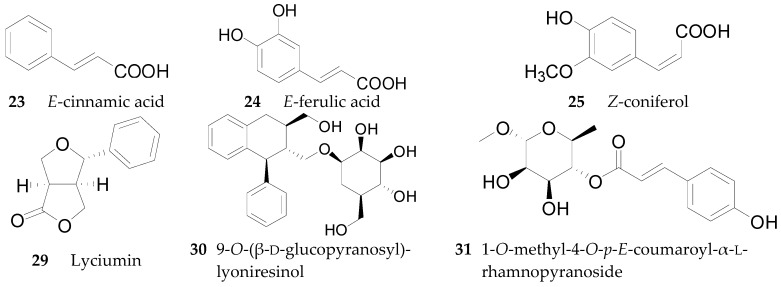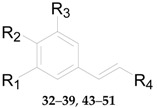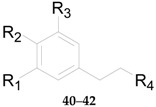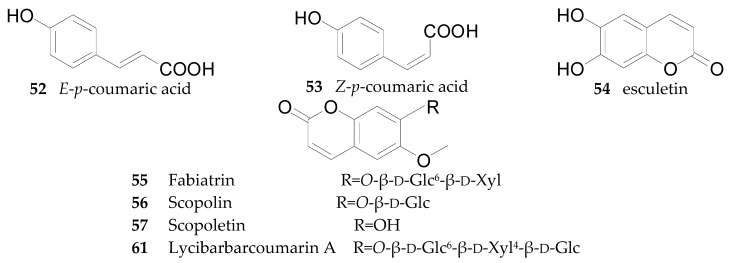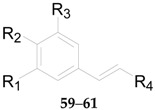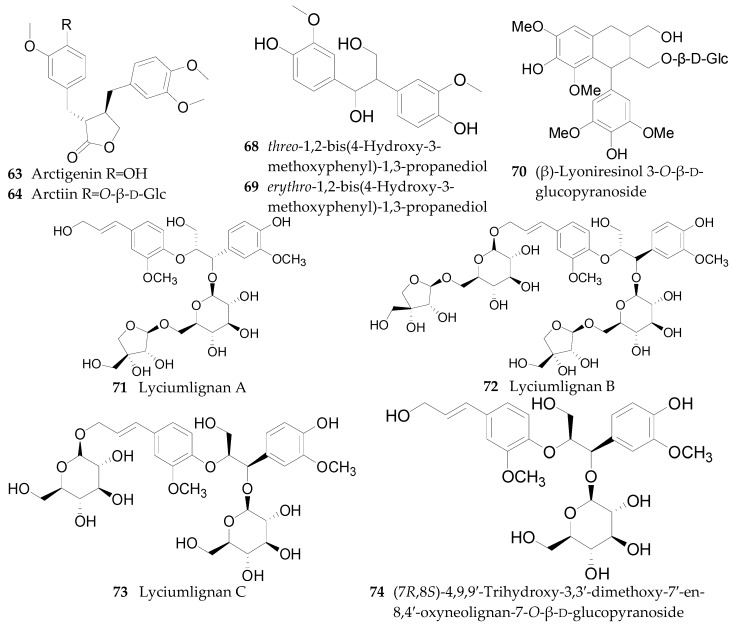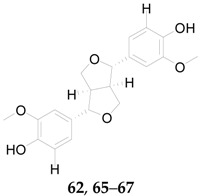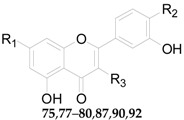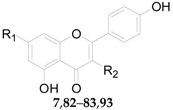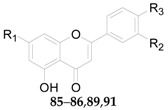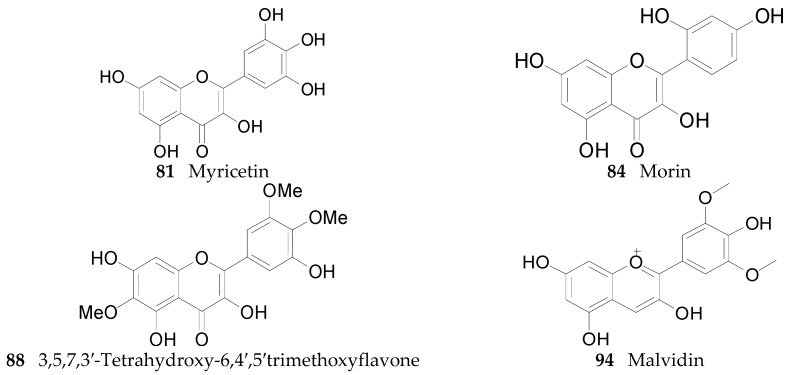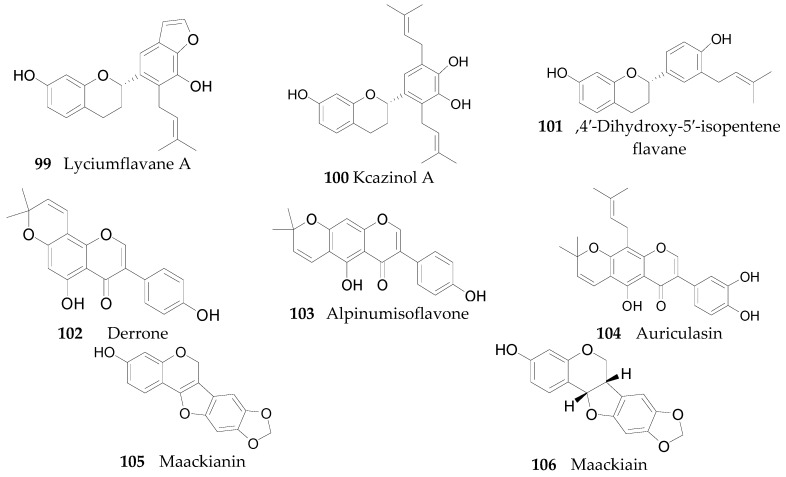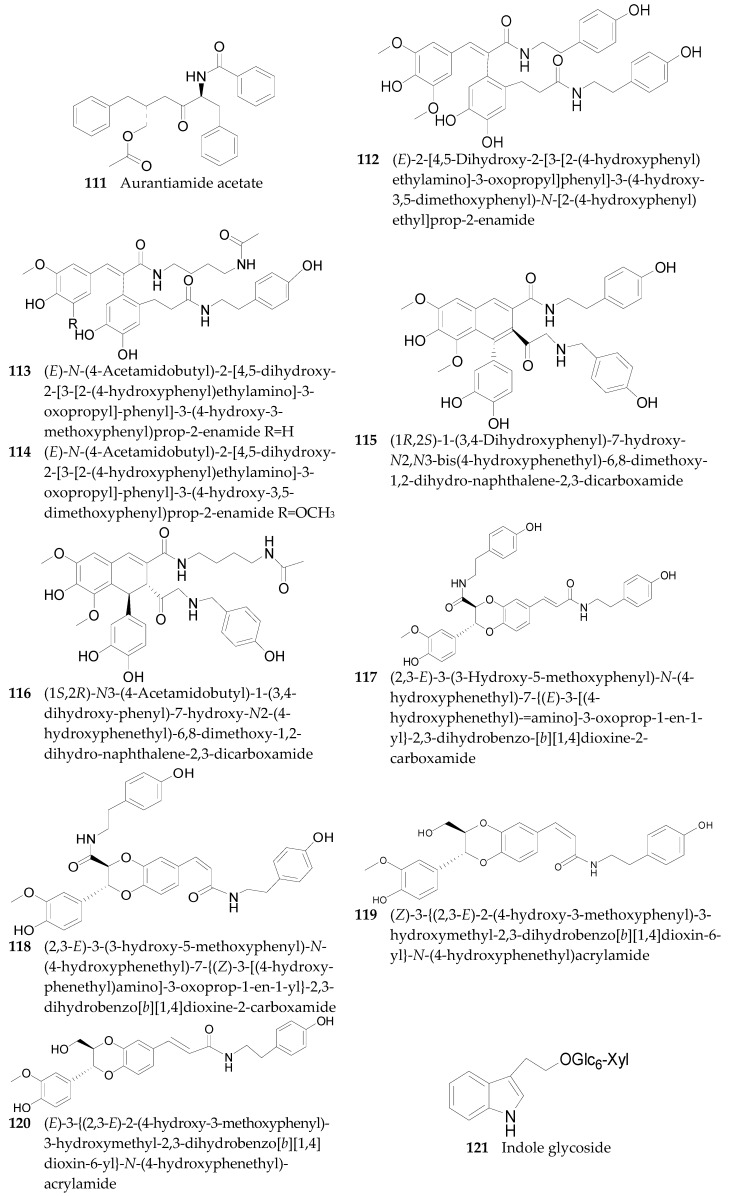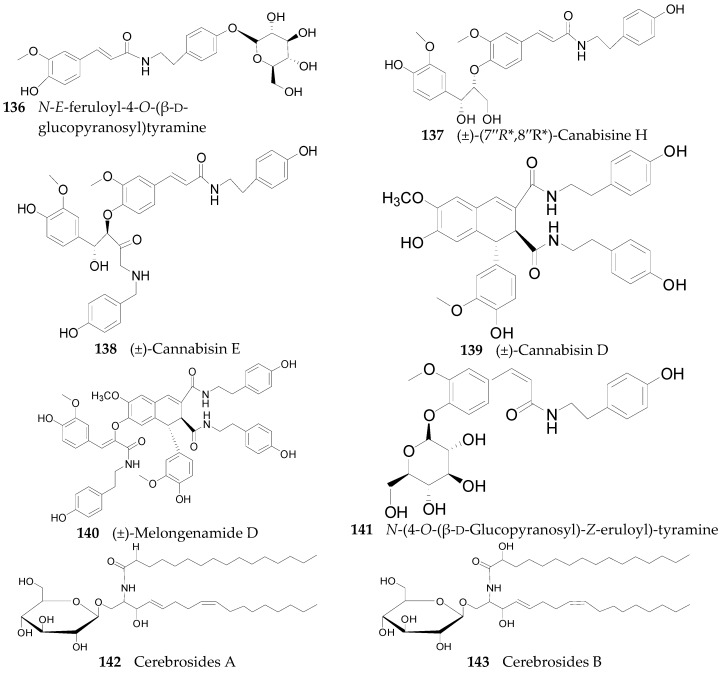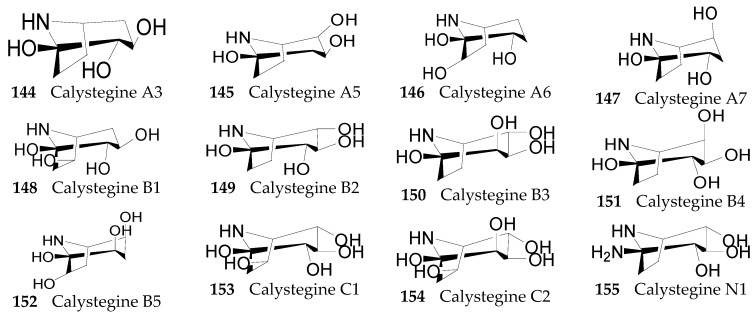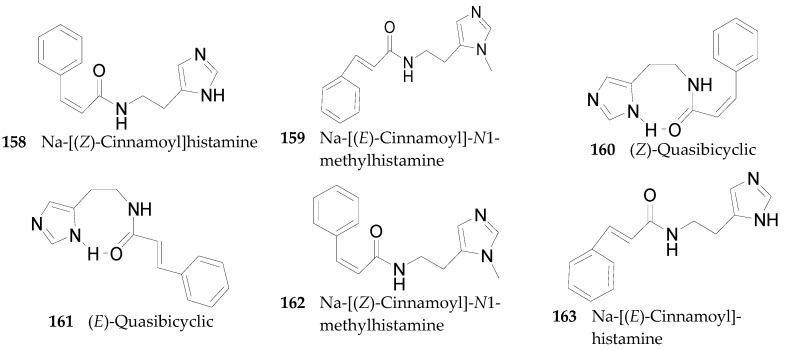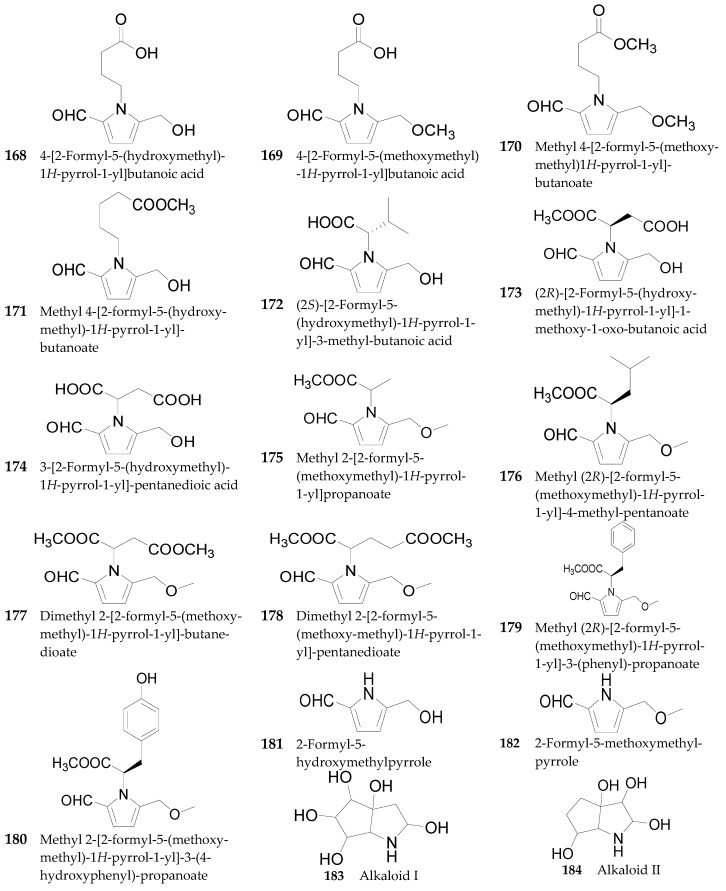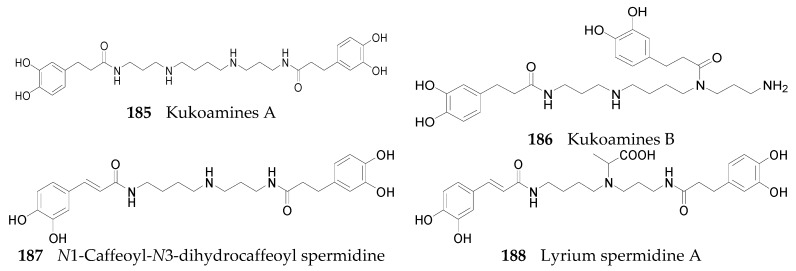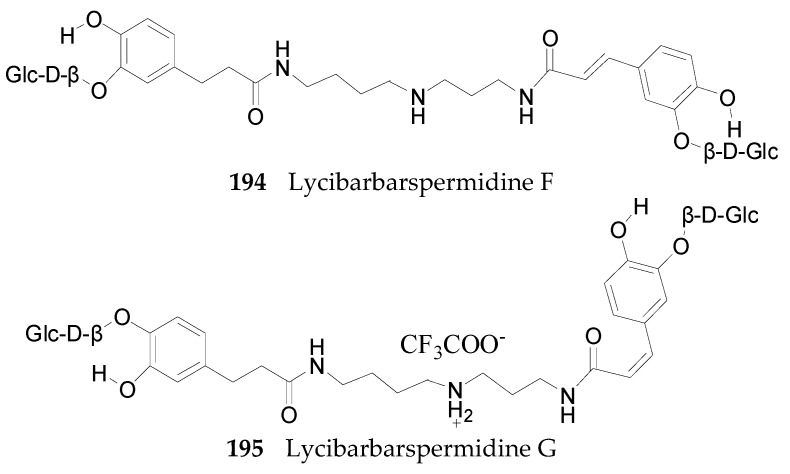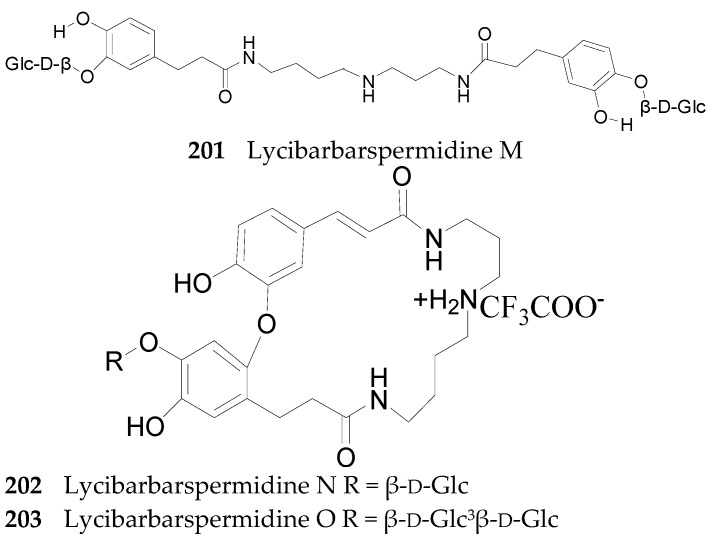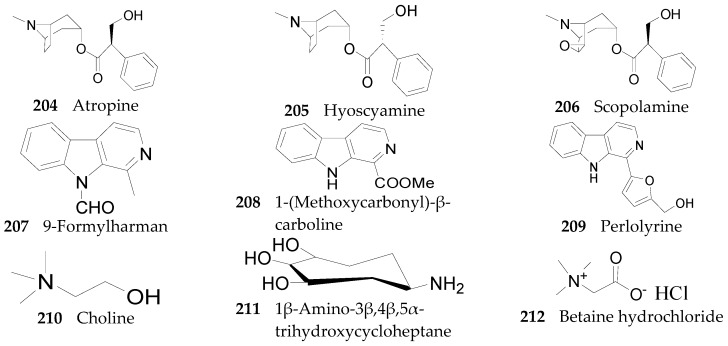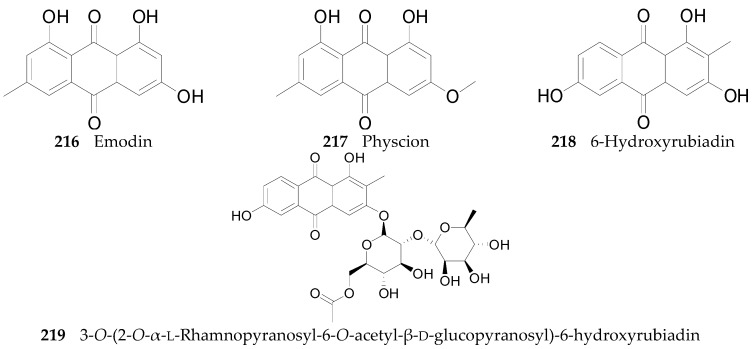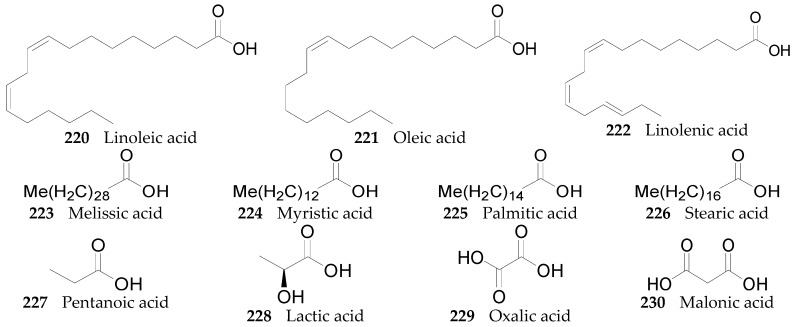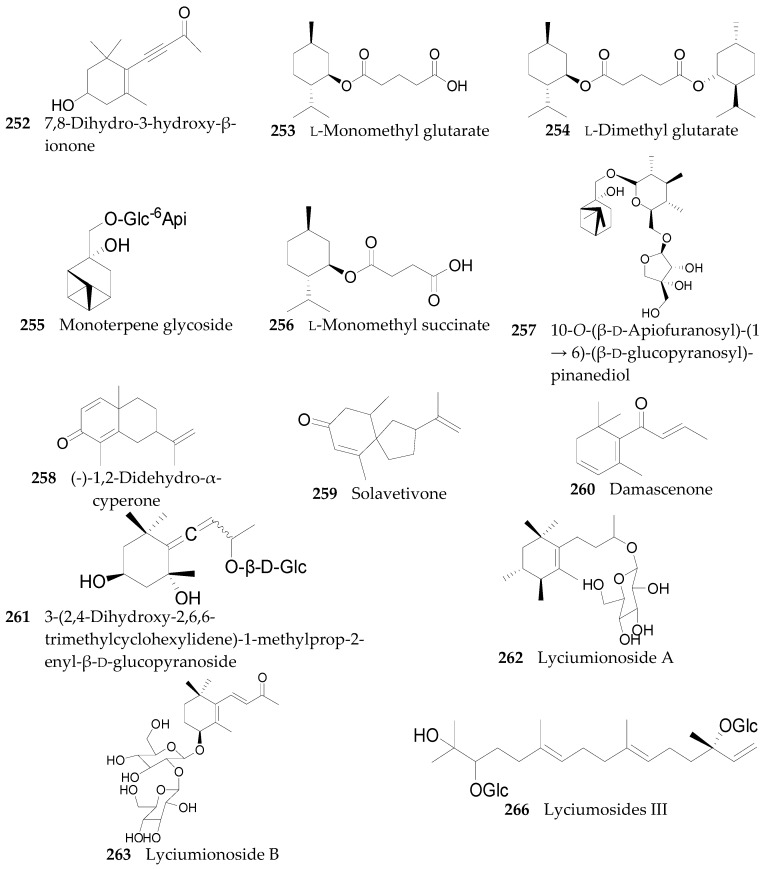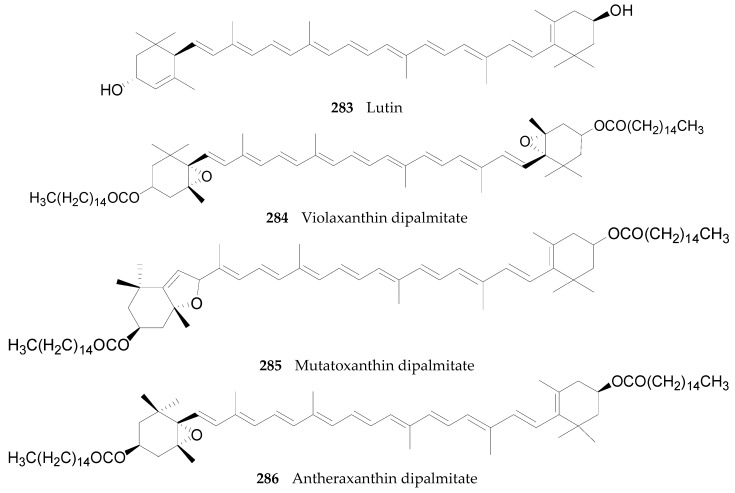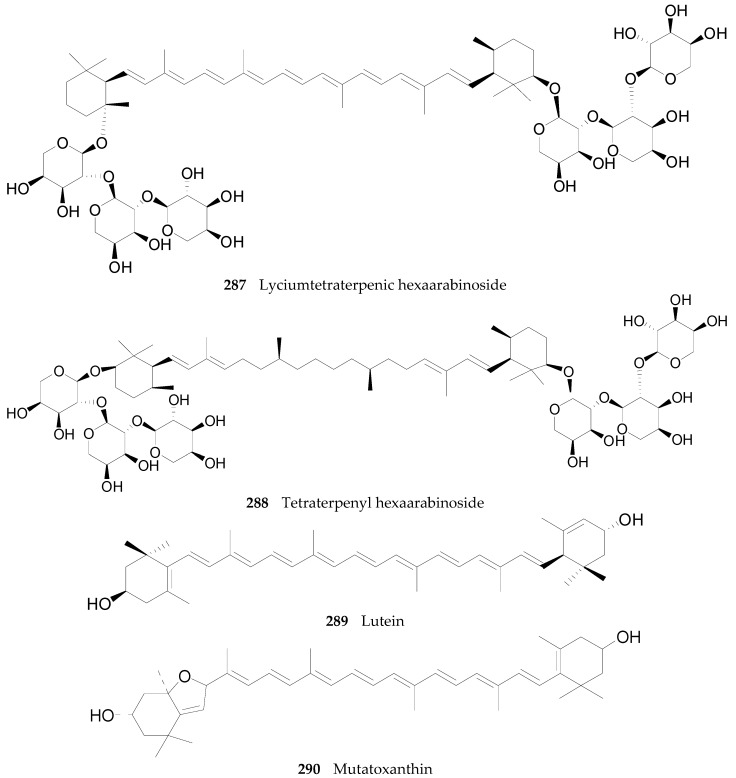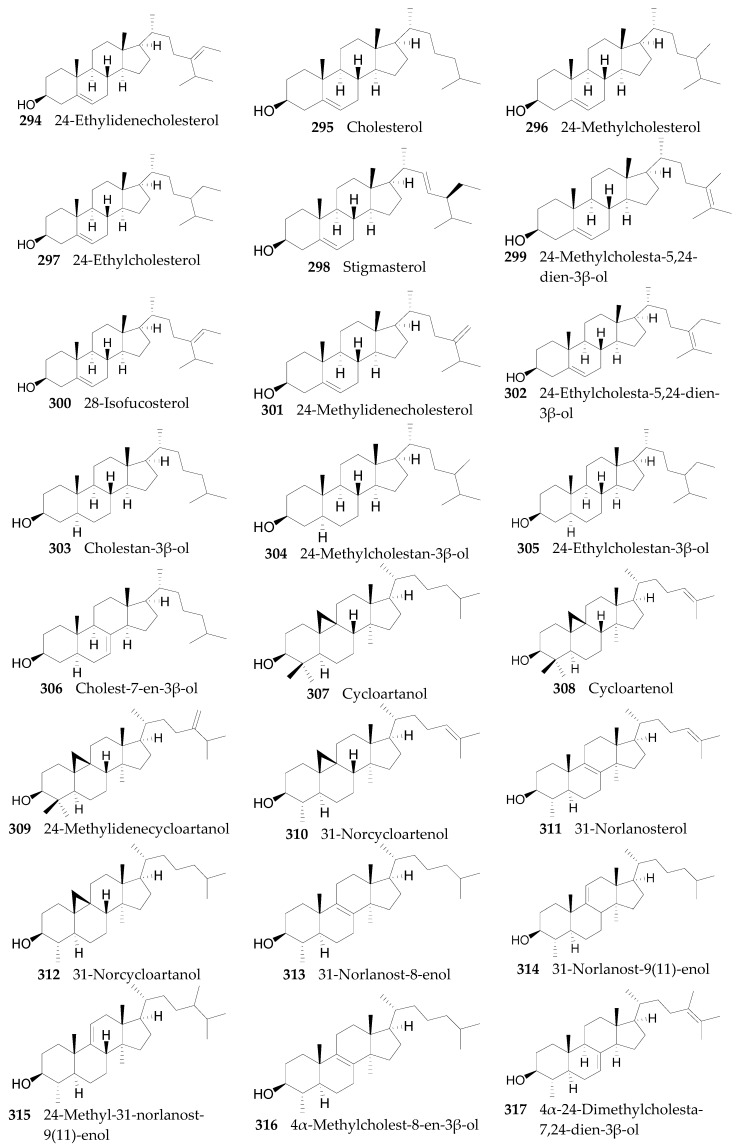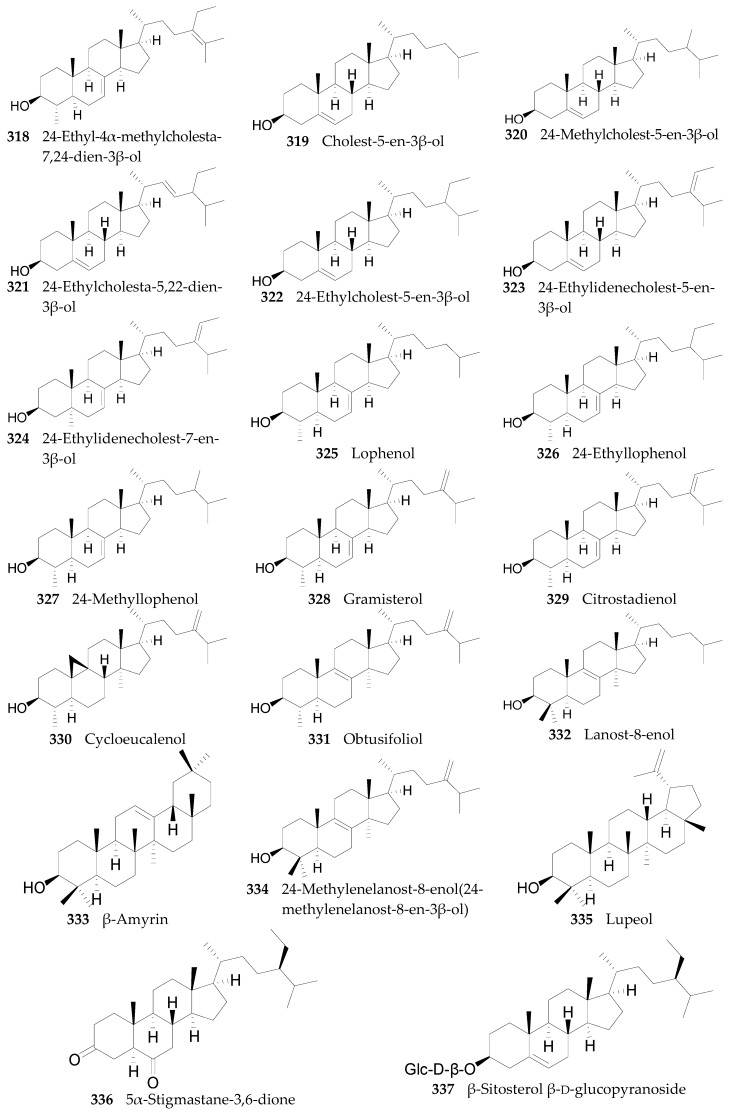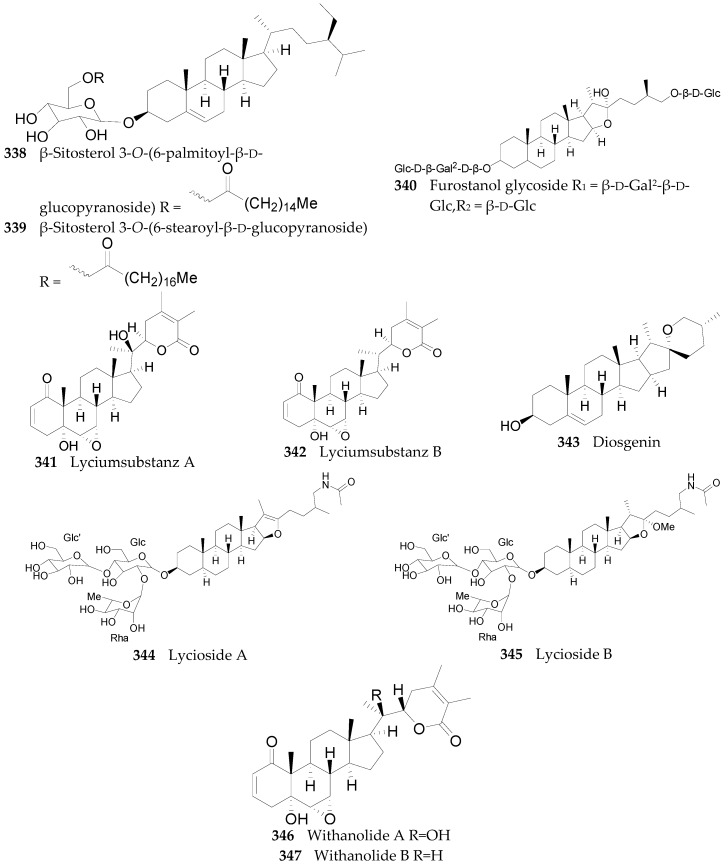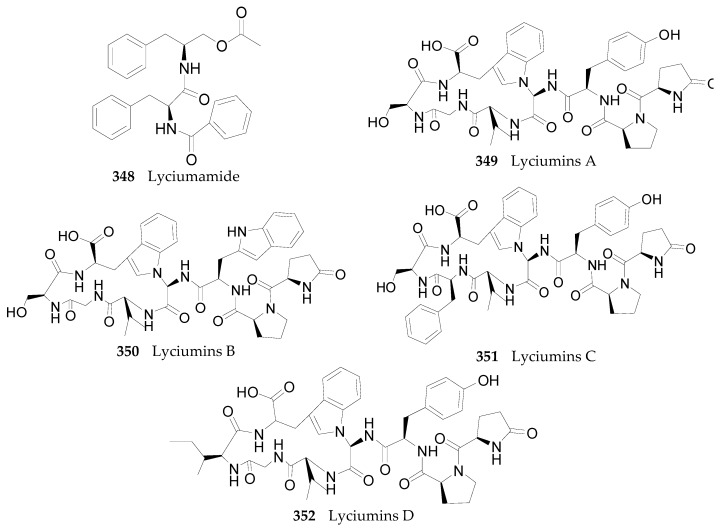Abstract
The Lycium genus is widely used as a traditional Chinese medicine and functional food. Many of the chemical constituents of the genus Lycium were reported previously. In this review, in addition to the polysaccharides, we have enumerated 355 chemical constituents and nutrients, including 22 glycerogalactolipids, 29 phenylpropanoids, 10 coumarins, 13 lignans, 32 flavonoids, 37 amides, 72 alkaloids, four anthraquinones, 32 organic acids, 39 terpenoids, 57 sterols, steroids, and their derivatives, five peptides and three other constituents. This comprehensive study could lay the foundation for further research on the Lycium genus.
Keywords: Lycium genus, chemical constituents, goji berry, Lycii cortex
1. Introduction
Lycium is one of the genera in the Solanaceae family, comprising 80 species, seven of which are found in China [1]. These species are all deciduous shrubbery, possessing a highly similar morphology and structure. The Lycium genus has been an important source of medicines and nutrient supplements for thousands of years in Southeast Asia, especially in China. Two species in particular, Lycium barbarum and Lycium chinense, have been widely used as traditional Chinese medicinal herbs for centuries and L. barbarum is currently widely cultivated in China.
Goji berries (Chinese name Gouqizi), which are derived from the fruits of Lycium Linn, have been used as traditional herbs for a long time in China for their benefits of replenishing vital essence to improve eyesight, nourish the liver and kidneys. Lycii cortex is a “heat cleansing” drug that is derived from the root bark of L. chinense and L. barbarum [2]. Goji berries and Cortex Lycii have demonstrated good therapeutic effects in some chronic diseases such as hectic fever, night sweats, cough, hemoptysis, and diabetes. Recently, medical research has indicated that these fruits and root bark have many pharmacological functions, such as antiglaucoma, immunoregulatory, antitumor, antioxidant, antiaging, neuroprotective, and blood sugar level reducing activities [3,4,5,6,7,8,9,10].
Traditionally, the berry and root bark available have been used as medicinal sources, as well as important components in some traditional Chinese patent medicines. They are not only famous medical herbs, but are also functional foods widely consumed in health-preserving cuisines, i.e., soups, congee, herbal tea, etc. People also eat the fresh leaves as vegetables. In particular, goji berries have become increasingly popular for improving overall well-being and as an anti-aging remedy. There are many goji derived-products on health food market, such as dried fruits, juice, goji wine and goji yoghurt. Many research papers were published focused on the phytochemical fingerprinting and antioxidant activity of these products [11,12,13,14].
Two valuable medicinal herbs, namely L. barbarum and L. chinense, have received remarkable attention due to their effective clinical therapy, especially in the anti-aging category. In addition, there are increasing numbers of publications about several other Lycium plants, i.e., Lycium ruthenicum [15,16]. Many researchers have focused great attention on the Lycium genus in recent years, and many chemical components from this genus have been isolated. Therefore, a comprehensive and systematic review on the chemical constituents of the Lycium genus is much needed.
Most of the published reviews not only covered chemical composition, but also summarized the pharmacology, clinical studies, safety, toxicology and adverse actions of L. barbarum or L. chinense [17,18,19]. The aim of this review was to focus on chemical constituents in different parts of plants from different species in Lycium genus, especially small molecular compounds with updated research reports. This paper comprehensively summarizes the reports of constituents from the genus Lycium. Up to 2016, at least 355 constituents were reported from different species in the Lycium genus and different parts (fruits, root bark, leaves, seeds, and flowers) of the plant. This review describes the advances in the phytochemistry of the genus Lycium from 1975 to 2016, based on the 142 cited references. The reported constituents can be classified as glycerogalactolipids, phenylpropanoids, coumarins, lignans, flavonoids, amides, alkaloids, anthraquinones, organic acids, terpenoids, sterols, steroids, peptides, and other constituents. The aim of this review is to illustrate the recent advances in the characterization of the Lycium genus. The results, based on these phytochemical studies, could lay a solid foundation for better understanding of pharmacological activities of Lycium and quality assessment.
2. Constituents
Until now, other than polysaccharides, more than 355 compounds have been isolated and identified from the Lycium genus. The small molecules can be assigned to various classes of glycerogalactolipids, phenylpropanoids, coumarins, lignans, flavonoids, amides, alkaloids, anthraquinones, organic acids, terpenoids, sterols, steroids and their derivatives, and peptides. Beyond that, other groups of compounds have also been reported. The proportion of different compounds of the Lycium genus is show in Figure 1. Their structures are shown below, and their names and corresponding plant sources are included in this paper.
Figure 1.
Different subtype comparison of the 355 constituents reported from Lycium genus.
2.1. Macromolecules in the Lycium Genus
Polysaccharides
Polysaccharides are the most important group of substances in the goji berry, which are estimated to comprise 5–8% of the dried fruits [20], 1.02–2.48% of the raw material [21,22,23]. More than 40 polysaccharides, with a molecular weight range of 8–241 kDa, were isolated from the fruit of L. barbarum, L. chinense and L. ruthenicum. Two, LRLP4-A and LBLP5-A, were isolated from the leaves of L. ruthenicum. The polysaccharides share a glycan-O-Ser glycopeptide structure and contain galacturonic acid, 18 amino acids, and nine monosaccharides, namely, xylose (Xyl), glucose (Glc), arabinose (Ara), rhamnose (Rha), mannose (Man), galactose (Gal), fucose (Fuc), galacturonic acid (GalA), glucuronic acid (GlcA) [24]. The molar ratios of the polysaccharides are shown in Table 1. The polysaccharides can be isolated and purified by water extract alcohol precipitation, DEAE ion-exchange cellulose, gel-permeation chromatography, high performance liquid chromatography (HPLC). Sevage method and organic reagents were used to remove proteins, pigments and other impurities. The structural composition of a LBP can be studied by SDS-PAGE gel electrophoresis, high perfomance size exclusion chromatography (HPSEC), gas-chromatographic–mass-spectrometry (GC-MS), nucleic magnetic resonance (NMR), and matrix-assisted laser desorption ionization-time of flight-mass spectrometry (MALDI-Tof-MS) [18,21,25].
Table 1.
The molar ratios and source of LBPs.
| LBPs | Molar Ratio | Source | Reference |
|---|---|---|---|
| LbGp1 | Ara:Gal:Glc = 2.5:1.0:1.0 | L. barbarum | [26] |
| LbGp2 | Ara:Gal = 4:5 | L. barbarum | [27] |
| LbGp3 | Ara:Gal = 1:1 | L. barbarum | [28,29] |
| LbGp4 | Ara:Gal:Rha:Glc = 1.5:2.5:0.43:0.23 | L. barbarum | [28,30] |
| LbGp5 | Rha:Ara:Xyl:Gal:Man:Glc = 0.33:0.52:0.42:0.94:0.85:1 | L. barbarum | [28] |
| LbGp5B | Rha:Ara:Glc:Gal = 0.1:1:1.2:0.3 | L. barbarum | [31] |
| LBP3p | Rha:Ara:Xyl:Gal:Man:Glc = 1.25:1.10:1.76:1:1.95:2.12 | L. barbarum | [32] |
| LBPC2 | Xyl:Rha:Man = 8.8:2.3:1 | L. barbarum | [33] |
| LBPC4 | Glc | L. barbarum | [33] |
| LBPA1 | heteroglycan | L. barbarum | [33] |
| LBPA3 | heteroglycan | L. barbarum | [33] |
| LBP1a-1 | Glc | L. barbarum | [34] |
| LBP1a-2 | Glc | L. barbarum | [34] |
| LBP3a-1 | GalA | L. barbarum | [34] |
| LBP3a-2 | GalA | L. barbarum | [34] |
| LBPF1 | - | L. barbarum | [35] |
| LBPF2 | - | L. barbarum | [35] |
| LBPF3 | - | L. barbarum | [35] |
| LBPF4 | - | L. barbarum | [35] |
| LBPF5 | Ara, Man, Xyl, Glu, Rha | L. barbarum | [35,36] |
| LBPF6 | - | L. barbarum | [36] |
| LPBC4 | Glc | L. barbarum | [37] |
| LBP-1 | Rha:Ara:Xyl:Gal:Man:GalA = 1:7.85:0.37:0.65:3.01:8.16 | L. barbarum | [22] |
| WSP1 | Rha:Fuc:Ara:Xyl:Man:Gal:Glc = 1.6:0.2:51.4:4.8:1.2:25.9:7.3 | L. barbarum | [23] |
| AGP | Rha:Ara:Xyl:Gal:Glc:GalA:GlcA = 3.3:42.9:0.3:44.3:2.4:7.0 | L. barbarum | [38] |
| LBP-IV | Rha:Ara:Xyl:Glc:Gal = 1.61:3.82:3.44:7.54:1.00 | L. barbarum | [39] |
| LbGp1 | Ara:Gal = 5.6:1 | L. barbarum | [40] |
| LBP-s-1 | Rha:Ara:Xyl:Man:Glu:Gal:Gal A = 1.00:8.34:1.25:1.26:1.91:7.05:15.28 | L. barbarum | [41] |
| p-LBP | Fuc:Rha:Ara:Gal:Glc:Xyl:Gal A:Glc A = 1.00:6.44:54.84:22.98:4.05:2.95:136.98:3.35 | L. barbarum | [42] |
| Cp-2-A | Ara:Gal:Man:Rha:Glu = 6.02:2.71:1.00:0.70:0.67 | L. chinese | [43,44] |
| Cp-2-B | Ara:Gal = 1:0.96 | L. chinese | [43,44] |
| Hp-2-A | Ara:Gal = 5.2:1 | L. chinese | [43,44] |
| Hp-2-B | Ara:Gal = 7.9:1 | L. chinese | [43,44] |
| Hp-2-C | Ara:Gal = 1.2:1 | L. chinese | [43,44] |
| Hp-0-A | Ara:Gal = 14:1 | L. chinese | [43,44] |
| Cp-1-A | Ara:Xyl = 1:1 | L. chinese | [45] |
| Cp-1-B | Ara | L. chinese | [45] |
| Cp-1-C | Ara:Gal = 3:1 | L. chinese | [45] |
| Cp-1-D | Ara:Gal = 1:1 | L. chinese | [45] |
| LRGP1 | Rha:Ara:Xyl:Man:Glu:Gal = 0.65:10.71:0.33:0.67:1:10.41 | L. ruthenicum | [46] |
| LRGP2 | - | L. ruthenicum | [47] |
| LRGP3 | Rha:Ara:Gal = 1.0:14.9:10.4 | L. ruthenicum | [48] |
| LRGP4-A | Rha:Ara:Glu:Gal = 1:7.6:0.5:8.6 | L. ruthenicum | [49] |
| LRGP5 | Rha:Ara:Xyl:Gal:GalA = 1.0:2.2:0.5:1.2:4.7 | L. ruthenicum | [50] |
| LRLP4-A | Rha:Ara:Gal = 1:10.3:5.3 | L. ruthenicum | [47] |
| LBLP5-A | - | L. ruthenicum | [51] |
2.2. Small Molecule Substances
2.2.1. Glycerogalactolipids 1–22
At present, 17 compounds of this type, a series of glycerogalactolipids 1–17, listed in Table 2, have been isolated and identified. Compounds 1–15 have been isolated and identified from the fruits of L. barbarum [52], whereas 16 and 17 were isolated from the fruits of L. chinense [53]. Compounds 18–22, illustrated in Figure 2, were isolated from the root bark of L. chinense [54,55].
Table 2.
Chemical structures of compounds 1–17.
| No. | Compounds | R1 | R2 | R3 | Source |
|---|---|---|---|---|---|
| 1 | Glycerogalactolipids A | Palmitoyl | Linolenoyl | Linolenoyl | L. barbarum |
| 2 | Glycerogalactolipids B | Palmitoyl | Linolenoyl | Linoleoyl | L. barbarum |
| 3 | Glycerogalactolipids C | Palmitoyl | Linolenoyl | Palmitoyl | L. barbarum |
| 4 | Glycerogalactolipids D | Palmitoyl | Linoleoyl | Palmitoyl | L. barbarum |
| 5 | Glycerogalactolipids E | Palmitoyl | Palmitoyl | Palmitoyl | L. barbarum |
| 6 | Glycerogalactolipids F | Palmitoyl | Palmitoyl | H | L. barbarum |
| 7 | Glycerogalactolipids G | Linolenoyl | Linolenoyl | H | L. barbarum |
| 8 | Glycerogalactolipids H | Linolenoyl | Linoleoyl | H | L. barbarum |
| 9 | Glycerogalactolipids I | Palmitoyl | Linolenoyl | H | L. barbarum |
| 10 | Glycerogalactolipids J | Palmitoyl | Linoleoyl | H | L. barbarum |
| 11 | Glycerogalactolipids K | Palmitoyl | Oleoyl | H | L. barbarum |
| 12 | Glycerogalactolipids L | Stearoyl | Linoleoyl | H | L. barbarum |
| 13 | Glycerogalactolipids M | Palmitoyl | Linolenoyl | – | L. barbarum |
| 14 | Glycerogalactolipids N | Palmitoyl | Linoleoyl | – | L. barbarum |
| 15 | Glycerogalactolipids O | Palmitoyl | Oleoyl | – | L. barbarum |
| 16 | Glycerogalactolipids P | Linolenoyl | Linolenoyl | – | L. chinense |
| 17 | Glycerogalactolipids Q | Linoleoyl | Linolenoyl | – | L. chinense |
Figure 2.
Chemical structures of compounds 18–22.
2.2.2. Phenylpropanoids 23–51
Four phenylpropanoids 23–26, namely E-cinnamic acid (23), E-ferulic acid (24), E-coniferol (25) and isoscopoletin (26) are obtained from wolfberries [56,57,58]. Four phenylpropanoids, namely scopolin (27), fabiatrin (28), lyciumin (29), and 9-O-(β-d-glucopyranosyl)lyoniresinol (30) are obtained from the root bark of L. chinense [59,60,61]. 1-O-Methyl-4-O-p-E-coumaroyl-α-l-rhamnopyranoside (31) is obtained from the fruits of L. ruthenicum [62]. The chemical structures of compounds 23–33 are listed in Table 3 and Figure 3. In 2016, 11 phenylpropanoids 32–42 were isolated for the first time by Zhou et al. from Lycium [56], including 1-O-E-feruloyl-6-O-β-d-xylopyranosyl-β-d-glucopyranoside (32), 6-O-E-feruloyl-2-O-β-d-glucopyranosyl-α-d-glucopyranoside (33), 1-O-E-feruloyl-β-d-glucopyranoside (34), ethyl-4-O-β-d-glucopyranosyl-E-ferulate (35), ethyl E-ferulate (36), E-sinapinic acid (37), syringenin (38), Z-ferulic acid (39), phloretic acid (40), dihydroferulic acid (41), and ethyl dihydroferulate (42), along with the nine new lycibarbarphenylpropanoids A–I (compounds 43–51) listed in Table 4.
Table 3.
Chemical structures of compounds 26–28.
| No. | Compounds | R1(R) | R2 | Source |
|---|---|---|---|---|
| 26 | Isoscopoletin | OCH3 | OH | L. barbarum |
| 27 | Scopolin | O-β-d-Glc | OCH3 | L. chinense |
| 28 | Fabiatrin | O-β-d-Glc6-β-d-Xyl | OCH3 | L. chinense |
Figure 3.
Chemical structures of compounds 23–25, 29–31.
Table 4.
Chemical structures of compounds 32–51.
| No. | Compounds | R1 | R2 | R3 | R4 | Source |
|---|---|---|---|---|---|---|
| 32 | 1-O-E-feruloyl-6-O-β-d-xylopyranosyl-β-d-glucopyranoside | OCH3 | OH | H | COO-β-d-Glc6-β-d-Xyl | L. barbarum |
| 33 | 6-O-E-feruloyl-2-O-β-d-glucopyranosyl-α-d-glucopyranoside | OCH3 | OH | H | COO6-α-d-Glc2-β-d-Glc | L. barbarum |
| 34 | 1-O-E-feruloyl-β-d-glucopyranoside | OCH3 | OH | H | COO-β-d-Glc | L. barbarum |
| 35 | Ethyl-4-O-β-d-glucopyranosyl-E-ferulate | OCH3 | O-β-d-Glc | H | COOCH2CH3 | L. barbarum |
| 36 | Ethyl E-ferulate | OCH3 | OH | H | COOCH2CH3 | L. barbarum |
| 37 | E-sinapinic acid | OCH3 | OH | OCH3 | COOH | L. barbarum |
| 38 | Syringenin | OCH3 | OH | OCH3 | CH2OH | L. barbarum |
| 39 | E-ferulic acid | OCH3 | OH | H | COOH | L. barbarum |
| 40 | Phloretic acid | H | OH | H | COOH | L. barbarum |
| 41 | Dihydroferulic acid | OCH3 | OH | H | COOH | L. barbarum |
| 42 | Ethyl dihydroferulate | OCH3 | OH | H | COOCH2CH3 | L. barbarum |
| 43 | Lycibarbarphenylpropanoids A | H | OH | H | COO-β-d-Glc3-β-d-Glc | L. barbarum |
| 44 | Lycibarbarphenylpropanoids B | H | OH | H | COO-β-d-Glc4-β-d-Glc | L. barbarum |
| 45 | Lycibarbarphenylpropanoids C | OCH3 | OH | H | COO-β-d-Glc3-β-d-Glc | L. barbarum |
| 46 | Lycibarbarphenylpropanoids D | OCH3 | OH | H | COO-β-d-Glc4-β-d-Glc | L. barbarum |
| 47 | Lycibarbarphenylpropanoids E | OCH3 | OH | H | CH2O-β-d-Glc3-β-d-Glc | L. barbarum |
| 48 | Lycibarbarphenylpropanoids F | H | O-β-d-Glc3-β-d-Glc | H | COOCH2CH3 | L. barbarum |
| 49 | Lycibarbarphenylpropanoids G | H | O-β-d-Glc4-β-d-Glc | H | COOCH2CH3 | L. barbarum |
| 50 | Lycibarbarphenylpropanoids H | OCH3 | O-β-d-Glc4-β-d-Glc | H | COOCH2CH3 | L. barbarum |
| 51 | Lycibarbarphenylpropanoids I | O-β-d-Glc | OH | H | COOCH2CH3 | L. barbarum |
2.2.3. Coumarins 52–61
Nine coumarins, namely E-p-coumaric acid (52), Z-p-coumaric acid (53), esculetin (54), fabiatrin (55), scopolin (56), and scopoletin (57), have been reported, and three new coumarins, 6-O-E-p-coumaroyl-2-O-β-d-glucopyranosyl-α-d-glucopyranoside (58), ethyl-4-O-β-d-glucopyranosyl-E-p-coumarate (59), ethyl E-p-coumarate (60) and lycibarbarcoumarin A (61), have been obtained from the fruits of L. barbarum in 2016 [56]. Compounds 55 and 56 were isolated from the root bark and fruits of L. chinense [61], while 52−54 and 57 were isolated from the fruits of L. barbarum [63]. The chemical structures of these coumarins are listed in Figure 4 and Table 5.
Figure 4.
Chemical structures of compounds 52–57, 61.
Table 5.
Chemical structures of compounds 58–60.
| No. | Compounds | R1 | R2 | R3 | R4 | Source |
|---|---|---|---|---|---|---|
| 58 | 6-O-E-p-coumaroyl-2-O-β-d-glucopyranosyl-α-d-glucopyranoside | H | OH | H | COO6-α-d-Glc2-β-d-Glc | L. barbarum |
| 59 | Ethyl-4-O-β-d-glucopyranosyl-E-p-coumarate | H | O-β-d-Glc | H | COOCH2CH3 | L. barbarum |
| 60 | Ethyl E-p-coumarate | H | OH | H | COOCH2CH3 | L. barbarum |
2.2.4. Lignans 62–74
Eight lignans, including pinoresinol (62), arctigenin (63), arctiin (64), medioresinol (65), syringaresinol (66), 4-O-(β-d-glucopyranosyl)syringaresinol (67), threo-1,2-bis(4-hydroxy-3-methoxy-phenyl)-1,3-propanediol (68), and erythro-1,2-bis(4-hydroxy-3-methoxyphenyl)-1,3-propanediol (69), have been isolated from the fruits of L. barbarum [56]. (β)-Lyoniresinol 3-O-β-d-glucopyranoside (70), lyciumlignan A (71), lyciumlignan B (72), lyciumlignan C (73), and (7R,8S)-4,9,9′-trihydroxy-3,3′-dimethoxy-7′-en-8,4′-oxyneolignan-7-O-β-d-glucopyranoside (74) were obtained from the root bark of L. chinense [54,60,64]. Among them, 65–70 were first isolated from the fruits of L. barbarum in 2016 [56]. The chemical structures of these lignans are listed in Figure 5 and Table 6.
Figure 5.
Chemical structures of compounds 63–64 and 68–74.
Table 6.
Chemical structures of compounds 62 and 65–67.
| No. | Compounds | R1 | R2 | R3 | Source |
|---|---|---|---|---|---|
| 62 | Pinoresinol | H | OH | H | L. barbarum |
| 65 | Medioresinol | H | OH | OCH3 | L. barbarum |
| 66 | Syringaresinol | OCH3 | OH | OCH3 | L. barbarum |
| 67 | 4-O-(β-d-glucopyranosyl)syringaresinol | OCH3 | O-β-d-Glc | OCH3 | L. barbarum |
2.2.5. Flavonoids 75–106
Twenty-seven flavonoids 75–101 have been reported from the genus Lycium, are listed in Table 7 and Table 8 and Figure 6 and Figure 7. Compound 75 was isolated from the flowers of L. barbarum [58], while 76–83 were identified from the fruits of L. barbarum [62,65,66,67,68,69]. Compound 84 was isolated from the fruits of L. chinense [70], whereas 85–91 were isolated from the leaves of L. chinense [62,66,68,71]. Compound 92 and 93 were isolated from the leaves of L. halimifolium [72]. Compounds 94–98 were isolated from the fruits of L. ruthenicum [16,62]. Compounds 99–101 were isolated from the root bark of L. chinense [54,73,74]. Additionally, Zhou et al. isolated five isoflavonoids, namely derrone (102), alpinumisoflavone (103), auriculasin (104), maackianin (105) and maackiain (106) from the fruits of L. barbarum [56,75,76].
Table 7.
Chemical structures of compounds 75–80, 82–83, 85–87 and 89–93.
| No. | Compounds | R1 | R2 | R3 | Source |
|---|---|---|---|---|---|
| 75 | Quercitrin | OH | OH | O-α-l-Rha | L. barbarum |
| 76 | Kaempferol | OH | OH | – | L. barbarum |
| 77 | Quercetin | OH | OH | OH | L. barbarum |
| 78 | Rutin | OH | OH | O-β-d-Glc6-α-l-Rha | L. barbarum |
| 79 | Narcissoside | OH | OCH3 | O-β-d-Glc6-α-l-Rha | L. barbarum |
| 80 | 7-O-(β-d-Glucopyranosyl)-rutin | O-β-d-Glc | OH | O-β-d-Glc6-α-l-Rha | L. barbarum |
| 82 | 7-O-(β-d-Glucopyranosyl)-nicotiflorin | O-β-d-Glc | O-β-d-Glc6-α-l-Rha | – | L. barbarum |
| 83 | 7-O-(β-d-Glucopyranosyl)-3-O-[β-d-glucopyranosyl]-(1 → 2)-β-d-galactop | O-β-d-Glc | O-β-d-Glc6-α-l-Glc | – | L. barbarum |
| 85 | Luteolin | OH | OH | OH | L. chinense |
| 86 | Acacetin | OH | H | OCH3 | L. chinense |
| 87 | 7-O-(β-d-Glucopyranosyl)-3-O-[β-d-glucopyranosyl-(1 → 2)-β-d-galactopyranosyl]-quercetin | O-β-d-Glc | OH | O-β-d-Glc2-β-d-Glc | L. chinense |
| 89 | 7-O-[α-l-Rhamno-pyranosyl-(1 → 6)-β-d-glucopyranosyl]-acacetin | O-β-d-Glc6-α-l-Rha | H | OCH3 | L. chinense |
| 90 | 3-O-Sophoroside-quercetin | OH | OH | O-β-d-Glc2-β-d-Glc | L. chinense |
| 91 | Apigenin | OH | H | OH | L. chinense |
| 92 | Isoquercitrin | OH | OH | O-β-d-Glc | L. halimifolium |
| 93 | Nicotiflorin | OH | O-β-d-Glc6-α-l-Rha | – | L. halimifolium |
Table 8.
Chemical structures of compounds 95–98.
| No. | Compounds | R1 | R2 | Source |
|---|---|---|---|---|
| 95 | 5-O-(β-d-Glucopyranosyl)-3-O-[4-O-p-E-coumaroyl-α-l-rhamnopyranosyl-(1 → 6)-β-d-glucopyranosyl]-peonidin | H | OH | L. ruthenicum |
| 96 | 5-O-(β-d-Glucopyranosyl)-3-O-[4-O-p-E-coumaroyl-α-l-rhamnopyranosyl-(1 → 6)-β-d-glucopyranosyl]-petunidin | OH | OH | L. ruthenicum |
| 97 | 5-O-(β-d-Glucopyranosyl)-3-O-[4-O-p-Z-coumaroyl-α-l-rhamnopyranosyl-(1 → 6)-β-d-glucopyranosyl]-malvidin | OCH3 | OH | L. ruthenicum |
| 98 | 5-O-(β-d-Glucopyranosyl)-3-O-[4-O-p-E-(β-d-glucopyranoside)-coumaroyl-α-l-rhamnopyranosyl-(1 → 6)-β-d-glucopyranosyl]-petunidin | OH | O-β-d-Glc | L. ruthenicum |
Figure 6.
Chemical structures of compounds 81, 84, 88 and 94.
Figure 7.
Chemical structures of compounds 99–106.
2.2.6. Amides 107–143
Sixteen amides 107–122 have been isolated from the root bark of L. chinense [9,54,60,77,78,79,80], 19 amides (123–141) have been isolated from the fruits of L. barbarum [81,82,83,84,85,86,87,88]. Meanwhile, two cerebrosides 142 and 143 have been obtained from fruits of L. chinense [89]. The chemical structures of these amides are shown in Figure 8.
Figure 8.
Chemical structures of compounds 107–143.
2.2.7. Alkaloids 144–215
To date, 72 alkaloids have been identified, which can be classified into five categories: nortropane, imidazole, piperidine, pyrrole, spermine, tropane, and other alkaloids.
Nortropane Alkaloids
Fourteen nortropane alkaloids 144–157, shiwn in Figure 9, have been isolated from the root bark of L. chinense [90].
Figure 9.
Chemical structures of compounds 144–157.
Imidazole Alkaloids
Six imidazole alkaloids 158–162 were detected in the leaves of L. cestroides [91]: Meanwhile, one imidazole, Na-[(E)-cinnamoyl]histamine (163), was obtained from the leaves of L. barbarum [66], listed in Figure 10.
Figure 10.
Chemical structures of compounds 158–163.
Piperidine Alkaloids
5-hydroxy-2-pyridylmethyl ketone (164), methyl 5-hydroxy-2-pyridinecarboxylate (165), fagomine (166), and 6-deoxyfagomine (167), listed in Figure 11, have been isolated and identified from the genus Lycium; among them. Compounds 164 and 165 are from the fruits of L. barbarum [92], and 166 and 167 are from the root bark of L. chinense [90].
Figure 11.
Chemical structures of compounds 164–167.
Pyrrole Alkaloids
Thirteen pyrrole alkaloids 168–180 have been isolated from the fruits of L. chinense [93,94,95]. Likewise, 2-formyl-5-hydroxymethylpyrrole (181) and 2-formyl-5-methoxymethylpyrrole (182) were isolated from the fruits of L. barbarum [92]. Two pyrrolidine alkaloids, alkaloid I (183) and alkaloid II (184), are obtained from the root bark of L. chinense [96]. The chemical structures of these pyrrole alkaloids are listed in Figure 12.
Figure 12.
Chemical structures of compounds 168–184.
Spermine Alkaloids
Nineteen spermine alkaloids have been found in the genus Lycium. Kukoamines A (185) and kukoamines B (186) are from the root bark of L. chinense [97,98], while N1-caffeoyl-N3-dihydrocaffeoyl spermidine (187) and lyrium spermidine A (188) are from the fruits of L. ruthenicum [62,99], listed in Figure 13. Another 15 spermine alkaloids, lycibarbarspermidine A–O (189–203), listed in Table 9 and Table 10 and Figure 13, Figure 14 and Figure 15, are from L. barbarum [100].
Figure 13.
Chemical structures of compounds 185–188.
Table 9.
Chemical structures of compounds 189–193.
| No. | Compounds | R1 | R2 | R3 | R4 | Source |
|---|---|---|---|---|---|---|
| 189 | Lycibarbarspermidine A | H | β-d-Glc | H | H | L. barbarum |
| 190 | Lycibarbarspermidine B | H | H | β-d-Glc | H | L. barbarum |
| 191 | Lycibarbarspermidine C | β-d-Glc | H | H | H | L. barbarum |
| 192 | Lycibarbarspermidine D | H | H | H | β-d-Glc | L. barbarum |
| 193 | Lycibarbarspermidine E | H | β-d-Glc | β-d-Glc | H | L. barbarum |
Table 10.
Chemical structures of compounds 196–200.
| No. | Compounds | R1 | R2 | R3 | R4 | Source |
|---|---|---|---|---|---|---|
| 196 | Lycibarbarspermidine H | H | H | H | β-d-Glc | L. barbarum |
| 197 | Lycibarbarspermidine I | H | β-d-Glc | H | H | L. barbarum |
| 198 | Lycibarbarspermidine J | H | H | β-d-Glc | H | L. barbarum |
| 199 | Lycibarbarspermidine K | β-d-Glc | H | β-d-Glc | H | L. barbarum |
| 200 | Lycibarbarspermidine L | H | β-d-Glc | H | β-d-Glc | L. barbarum |
Figure 14.
Chemical structures of compounds 194 and 195.
Figure 15.
Chemical structures of compounds 201–203.
Tropane Alkaloids
As we know, the genus Lycium has been used as both a medicine and a food for a long time in Asia, particularly in China. However, the safety of Lycium has been questioned for some time, especially after the detection of the three tropane alkaloids atropine (204), hyoscyamine (205), and scopolamine (206) [101]. Atropine and hyoscyamine were identified from the fruits of L. barbarum gathered in India, while scopolamine was identified from L. halimifolium at concentrations higher than the toxic dose. However, another scholar, seeking to verify these reports, demonstrated that the atropine content of L. barbarum from different sources was just 3.0 ppb—far below the poisoning dose [102]. It was demonstrated that none of the toxic compounds were detected in fruits, leaves, stems and roots of three L. barbarum varieties (‘No. 1’, ‘New Big’ and ‘Amber Sweet Goji’) by densitometric TLC analysis [103]. Through field investigation and model specimen inspections, the above three tropane alkaloids were determined to be from Lycium europaeum rather than the L. barbarum. Thus, the genus Lycium is likely non-toxic, and consumers can rest assured that its use is safe [104].
Other than the alkaloids that have been already mentioned, there are nine others that have been obtained from this genus, including 9-formylharman (207), 1-(methoxycarbonyl)-β-carboline (208), perlolyrine (209), choline (210), 1β-amino-3β,4β,5α-trihydroxycycloheptane (211), betaine hydrochloride (212), nicotianamine (213), betaine (214), and melatonin (215). Compounds 207–209 were isolated from the fruits of L. chinense [105], while 210–212 were isolated from the root bark of L. chinense [90]. Compound 213 was isolated from the leaves and flowers of L. chinense [106], and 214 and 215 were isolated from the fruits of L. barbarum [107,108]. The chemical structures of these tropane alkaloids are listed in Figure 16.
Figure 16.
Chemical structures of compounds 204–215.
2.2.8. Anthraquinones 216–219
Four anthraquinones: emodin (216), physcion (217), 6-hydroxyrubiadin (218), and 3-O-(2-O-α-l-rhamnopyranosyl-6-O-acetyl-β-d-glucopyranosyl)-6-hydroxy-rubiadin (219), listed in Figure 17, have been obtained from the root bark of L. chinense [61,109].
Figure 17.
Chemical structures of compounds 216–219.
2.2.9. Organic Acids 220–251
To this point, 32 organic acids, listed in Figure 18, have been identified from the genus Lycium, which can be classified into two groups: aliphatic acids 220–238 and aromatic acids and their derivatives 239–251. Compounds 220–225 and 240–244 were isolated from the fruits of L. barbarum [56,63,65,107,110,111,112]; 239 and 245 were isolated from the leaves of L. barbarum [66]; 226 was isolated from the root of L. chinense [113]; 227, 248 and 249 were isolated from the fruits of L. chinense [70,114]; 228–233 and 248 were isolated from the leaves of L. chinense [115]; 234, 235, and 249–251 were isolated from the root bark of L. chinense [53,78,93,116,117], and 236–238 were isolated from the fruits of L. urcomanicum [118,119].
Figure 18.
Chemical structures of compounds 220–251.
2.2.10. Terpenoids 252–290
Thirty-seven terpenoids, listed in Figure 19, Figure 20 and Figure 21 and Table 11 and Table 12, have been found in the genus Lycium, mainly including monoterpenes 252–256, sesquiterpenes 257–263, diterpenoids 264–274, and carotenoids 275–290. Among them, carotenoids are one of the more important constituents of the Lycium fruits. Thus compounds 256 and 275–286 were isolated from the fruits of L. barbarum [120,121,122,123]; 253, 254, 258, 259 and 287–290 were isolated from the fruits of L. chinense [120,121,124,125,126]; 252 and 264–272 were isolated from the leaves of L. chinense [127,128]; 255, 258 and 273–274 were isolated from the root bark of L. chinense [80,116]; 260 and 261 were isolated from the leaves of L. halimifolium [23]; and 262 and 265 were isolated from the leaves of L. barbarum [129].
Figure 19.
Chemical structures of compounds 252–263, 266.
Figure 20.
Chemical structures of compounds 271 and 274.
Figure 21.
Chemical structures of compounds 283–290.
Table 11.
Chemical structures of compounds 264–265, 267–270 and 272–273.
| No. | Compounds | R1 | R2 | Source |
|---|---|---|---|---|
| 264 | Lyciumosides I | Glc | Glc | L. chinense |
| 265 | Lyciumosides II | Glc2-Glc | Glc | L. chinense |
| 267 | Lyciumosides IV | Glc | Glc4-Rha | L. chinense |
| 268 | Lyciumosides V | Glc6-Rha | Glc | L. chinense |
| 269 | Lyciumosides VI | Glc6-Rha | Glc4-Rha | L. chinense |
| 270 | Lyciumosides VII | Glc2-Rha(6-Glc) | Glc | L. chinense |
| 272 | Lyciumosides IX | Glc | 6-O-malonyl-Glc | L. chinense |
| 273 | Capsianoside II | Rha3-Glc6-Rha | Glc2-Glc | L. chinense |
Table 12.
Chemical structures of compounds 275–282.
| No. | Compounds | R1 | R2 | Source |
|---|---|---|---|---|
| 275 | β-Carotene | H | H | L. barbarum |
| 276 | β-Cryptoxanthin | OH | H | L. barbarum |
| 277 | Zeaxanthin | OH | OH | L. barbarum |
| 278 | Zeaxanthin monopalmitate | OCO(CH2)14CH3 | OH | L. barbarum |
| 279 | Zeaxanthin dipalmitate | OCO(CH2)14CH3 | OCO(CH2)14CH3 | L. barbarum |
| 280 | Zeaxanthin monomyristate | OH | OCO(CH2)12CH3 | L. barbarum |
| 281 | Zeaxanthin dimyristate | OCO(CH2)12CH3 | OCO(CH2)12CH3 | L. barbarum |
| 282 | β-Cryptoxanthin palmitate | OCO(CH2)14CH3 | H | L. barbarum |
2.2.11. Sterols, Steroids, and Their Derivatives 291–347
Fifty-seven sterols, steroids, and their derivatives 291–347, listed in Figure 22, have been identified from the genus Lycium, mainly from the seeds and the fruits. Compounds 293 and 343 were identified from the flowers of L. barbarum [130], 291–292; 295, 298, 319–324 and 337–339 were identified from the fruits of L. chinense [23,35,52,63,107,131]; 341 342, 346 and 347 were identified from the leaves of L. chinense [132,133]; 336 and 340 were identified from the root bark of L. chinense [80,121]; 294 was identified from the seed of L. ciliatum [66]; all others were identified from the seed of L. chinense [134,135,136,137] 344 and 345 were identified from the seeds of L. barbarum [138].
Figure 22.
Chemical structures of compounds 291–347.
2.2.12. Peptides 348–352
Five peptides have been isolated from the root bark of L. chinense [80,139], including one dipeptide, lyciumamide (348), and four octapeptides, called lyciumins A–D (compounds 349–350), illustrated in Figure 23.
Figure 23.
Chemical structures of compounds 348–352.
2.2.13. Other Compounds 353–355
Other than what has already been mentioned, a few other chemical constituents, listed in Figure 24, were also isolated from the genus Lycium. Digupigan A (353), 2-O-(β-d-glucopyranosyl)ascorbic acid (354) and p-hydroxybenzaldehyde (355) also have been obtained from the root bark of L. chinense, the fruits of L. chinense, and the fruits of L. barbarum [75,76,121,137,140,141], respectively. Many minerals, amino acids, and proteins have also been found in the genus Lycium, such as Ca, Mg, Zn, Fe, aminoethanesulfonic acid, γ-aminobutyric acid (GABA), Mn-SOD, etc. [121,142,143].
Figure 24.
Chemical structures of compounds 353–355.
3. Discussion
Lycium species are of valuable medicinal, nutritional and functional significance, and have been studied in terms of their chemical compounds. Phytochemical investigations on eight different species, have resulted in the isolation of at least 355 constituents up to July of 2016. Research on chemical compounds has concentrated mainly on L. barbarum and L. chinense. Therefore, future phytochemistry research should be focused on the other species in Lycium genus. In addition, diverse plant parts (i.e., the flowers, leaves, seeds) have also been testified to contain new constituents, most of which possess the novel chemical structures. Polysaccharides play a particularly significant role in exerting pharmacological actions. A specific class of polysaccharides, abbreviated as LBP, is used as biomarker in the 2015 Chinese Pharmacopoeia as a measure by which wolfberry is qualified. At present, LBP in products or in pharmacological studies usually are polysaccharide mixtures with heterogeneity and polydispersity. On the other hand, development of new separation, detection techniques will greatly benefit the phytochemical isolation and structural elucidation of LBP. There is a growing recognition that not only the LBP, but also the plant secondary metabolites may have the potential active ingredients, while most of the research on goji berry was LBP rather than small molecule substances, so more intensive studies of goji berry are required to shed some light on these compounds.
Acknowledgments
This research was financially supported by The National Science Fund for Distinguished Young Scholars of China (81325023).
Author Contributions
D.Q. and L.H. conceived and designed the paper; D.Q. wrote the paper and L.H. reviewed the paper. Y.Z. and G.Y. discussed the results and commented on the manuscript. All authors read and approved the final manuscript.
Conflicts of Interest
The authors declare no conflict of interest.
References
- 1.Zhang Z.Y., Lu A.M., D‘Arcy W.G. Flora of China. Volume 17: Verbenaceae through Solanaceae. Science Press; Beijing, China: Missouri Botanical Garden Press; St. Louis, MO, USA: 1994. pp. 301–304. [Google Scholar]
- 2.Chinese Pharmacopoeia Commission . Pharmacopoeia of the People’s Republic of China Part I. Chemical Industry Press; Beijing, China: 2015. [Google Scholar]
- 3.Yuenshan H., Yu M.S., Suetyi Y., Kwokfai S., Waihung Y. Polysaccharides from wolfberry antagonizes glutamate excitotoxicity in rat cortical neurons. Cell. Mol. Neurobiol. 2009;29:1233–1244. doi: 10.1007/s10571-009-9419-x. [DOI] [PMC free article] [PubMed] [Google Scholar]
- 4.Yu M.S., Wong Y.Y., So K.F., Fang J.N., Yuen W.H., Chang C.C. New polysaccharide from Nerium indicum protects neurons via stress kinase signaling pathway. Brain Res. 2007;1153:221. doi: 10.1016/j.brainres.2007.03.074. [DOI] [PubMed] [Google Scholar]
- 5.Bie M., Lv Y., Ren C., Xing F., Cui Q., Xiao J., So K.F. Lycium barbarum polysaccharide improves bipolar pulse current-induced microglia cell injury through modulating autophagy. Cell Trans. 2015;24:419–428. doi: 10.3727/096368915X687453. [DOI] [PubMed] [Google Scholar]
- 6.Li H.Y., Ruan Y.W., Kau P.W., Chiu K., Chang R.C., Chan H.H., So K.F. Effect of Lycium barbarum (Wolfberry) on alleviating axonal degeneration after partial optic nerve transection. Cell Trans. 2015;24:403–417. doi: 10.3727/096368915X686896. [DOI] [PubMed] [Google Scholar]
- 7.Yu M., Ho Y., So K., Yuen W., Chang R. Cytoprotective effects of Lycium barbarum on cultured neurons against reducing stress on the endoplasmic reticulum. Int. J. Mol. Med. 2006;17:1157–1161. [PubMed] [Google Scholar]
- 8.Ye Z., Huang Q., Ni H.X., Wang D. Cortex Lycii Radicis extracts improve insulin resistance and lipid metabolism in obese-diabetic rats. Phytotherapy Res. 2008;22:1665–1670. doi: 10.1002/ptr.2552. [DOI] [PubMed] [Google Scholar]
- 9.Xie L.W., Atanasov A.G., Guo D.A., Malainer C., Zhang J.X., Zehl M., Guan S.H., Heiss E.H., Urban E., Dirsch V.M. Activity-guided isolation of NF-κB inhibitors and PPARγ agonists from the root bark of Lycium chinense Miller. J. Ethnopharmacol. 2014;152:470–477. doi: 10.1016/j.jep.2014.01.029. [DOI] [PubMed] [Google Scholar]
- 10.Behl T., Kotwani A. Chinese herbal drugs for the treatment of diabetic retinopathy. J. Pharm. Pharmacol. 2016;69:223–235. doi: 10.1111/jphp.12683. [DOI] [PubMed] [Google Scholar]
- 11.Donno D., Beccaro G.L., Mellano M.G., Cerutti A.K., Bounous G. Goji berry fruit (Lycium spp.): Antioxidant compound fingerprint and bioactivity evaluation. J. Funct. Foods. 2015;18:1070–1085. doi: 10.1016/j.jff.2014.05.020. [DOI] [Google Scholar]
- 12.Donno D., Mellano M.G., Raimondo E., Cerutti A.K., Prgomet Z., Beccaro G.L. Influence of applied drying methods on phytochemical composition in fresh and dried goji fruits by HPLC fingerprint. Eur. Food Res. Technol. 2016;242:1961–1974. doi: 10.1007/s00217-016-2695-z. [DOI] [Google Scholar]
- 13.Horszwald A., Andlauer W. Characterisation of bioactive compounds in berry juices by traditional photometric and modern microplate methods. J. Berry Res. 2011;1:189–199. [Google Scholar]
- 14.Yuan G., Ren J., Ouyang X., Wang L., Wang M., Shen X., Zhang B., Zhu B. Effect of Raw Material, Pressing and Glycosidase on the Volatile Compound Composition of Wine Made From Goji Berries. Molecules. 2016;21:1324. doi: 10.3390/molecules21101324. [DOI] [PMC free article] [PubMed] [Google Scholar]
- 15.Hongli J., Yanfang L., Zhimou G., Fan Y., Jixia W., Xiaolong L., Xiaojun P., Xinmiao L. High-performance liquid chromatography separation of cis-trans anthocyanin isomers from wild Lycium ruthenicum Murr. employing a mixed-mode reversed-phase/strong anion-exchange stationary phase. J. Agric. Chem. 2015;63:500. doi: 10.1021/jf504525w. [DOI] [PubMed] [Google Scholar]
- 16.Jin H., Zhao J., Zhou W., Shen A., Yang F., Liu Y., Guo Z., Zhang X., Tao Y., Peng X. Preparative separation of a challenging anthocyanin from Lycium ruthenicum Murr. by two-dimensional reversed-phase liquid chromatography/hydrophilic interaction chromatography. RSC Adv. 2015;5:62134–62141. doi: 10.1039/C5RA08713A. [DOI] [Google Scholar]
- 17.Potterat O. Goji (Lycium barbarum and L. chinense): Phytochemistry, pharmacology and safety in the perspective of traditional uses and recent popularity. Planta Med. 2010;76:7. doi: 10.1055/s-0029-1186218. [DOI] [PubMed] [Google Scholar]
- 18.Amagase H., Farnsworth N.R. A review of botanical characteristics, phytochemistry, clinical relevance in efficacy and safety of Lycium barbarum fruit (Goji) Food Res. Int. 2011;44:1702–1717. doi: 10.1016/j.foodres.2011.03.027. [DOI] [Google Scholar]
- 19.Kulczyński B., Gramzamichałowska A. Goji berry (Lycium barbarum): Composition and health effects—A review. Pol. J. Food Nutr. Sci. 2016;66:67–76. [Google Scholar]
- 20.Wang Q., Chen S.Q., Zhang Z.H. Determination of polysaccharide content in medlar. J. China Pharm. Univ. 1991;22:67–68. [Google Scholar]
- 21.Wu D.T., Lam S.C., Cheong K.L., Feng W., Lin P.C., Long Z.R., Lv X.J., Jing Z., Ma S.C., Li S.P. Simultaneous determination of molecular weights and contents of water-soluble polysaccharides and their fractions from Lycium barbarum collected in China. J. Pharm. Biomed. Anal. 2016;129:210–218. doi: 10.1016/j.jpba.2016.07.005. [DOI] [PubMed] [Google Scholar]
- 22.Zou S., Zhang X., Yao W., Niu Y., Gao X. Structure characterization and hypoglycemic activity of a polysaccharide isolated from the fruit of Lycium barbarum L. Carbohydr. Polym. 2010;80:1161–1167. doi: 10.1016/j.carbpol.2010.01.038. [DOI] [Google Scholar]
- 23.Redgwell R.J., Curti D., Wang J., Dobruchowska J.M., Gerwig G.J., Kamerling J.P., Bucheli P. Cell wall polysaccharides of Chinese Wolfberry (Lycium barbarum): Part 1. Characterisation of soluble and insoluble polymer fractions. Carbohydr. Polym. 2011;84:1344–1349. doi: 10.1016/j.carbpol.2011.01.032. [DOI] [Google Scholar]
- 24.Xie J.H., Tang W., Jin M.L., Li J.E., Xie M.Y. Recent advances in bioactive polysaccharides from Lycium barbarum L. Zizyphus jujuba Mill, Plantago spp. and Morus spp.: Structures and functionalities. Food Hydrocoll. 2016;60:148–160. doi: 10.1016/j.foodhyd.2016.03.030. [DOI] [Google Scholar]
- 25.Wu D.T., Cheong K.L., Deng Y., Lin P.C., Wei F., Lv X.J., Long Z.R., Zhao J., Ma S.C., Li S.P. Characterization and comparison of polysaccharides from Lycium barbarum in China using saccharide mapping based on PACE and HPTLC. Carbohydr. Polym. 2015;134:12. doi: 10.1016/j.carbpol.2015.07.052. [DOI] [PubMed] [Google Scholar]
- 26.Näf R., Velluz A., Thommen W. Isolation of a glucosidic precursor of damascenone from Lycium halimifolium mil. Tetrahedron Lett. 1990;31:6521–6522. doi: 10.1016/S0040-4039(00)97106-5. [DOI] [Google Scholar]
- 27.Peng X., Tian G. Structural characterization of the glycan part of glycoconjugate LbGp2 from Lycium barbarum L. Carbohydr. Res. 2001;331:95. doi: 10.1016/S0008-6215(00)00321-9. [DOI] [PubMed] [Google Scholar]
- 28.Huang L., Lin Y., Tian G., Ji G. Isolation, purification and physico-chemical properties of immunoactive constituents from the fruit of Lycium barbarum L. Acta Pharm. Sin. 1998;33:512–516. [PubMed] [Google Scholar]
- 29.Huang L.J., Tian G.Y., Ji G.Z. Structure elucidation of glycan of glycoconjugate LbGp3 isolated from the fruit of Lycium barbarum L. J. Asian Nat. Prod. Res. 1999;1:259–267. doi: 10.1080/10286029908039874. [DOI] [PubMed] [Google Scholar]
- 30.Peng X.M., Huang L.J., Qi C.H., Zhang Y.X., Tian G.Y. Studies on chemistry and immuno- modulating mechanism of a glycoconjugate from Lycium barbarum L. Chin. J. Chem. 2001;19:1190–1197. doi: 10.1002/cjoc.20010191206. [DOI] [Google Scholar]
- 31.Peng X.M., Qi C.H., Tian G.Y., Zhang Y.X. Physico-chemical Properties and Bioactivities of a Glycoconjugate LbGp5B from Lycium barbarum L. Chin. J. Chem. 2010;19:842–846. doi: 10.1002/cjoc.20010190906. [DOI] [Google Scholar]
- 32.Gan L., Hua Z.S., Liang Y.X., Bi X.H. Immunomodulation and antitumor activity by a polysaccharide-protein complex from Lycium barbarum. Int. Immunopharmacol. 2004;4:563. doi: 10.1016/j.intimp.2004.01.023. [DOI] [PubMed] [Google Scholar]
- 33.Zhao C., Li R., He Y., Guohui C. Studies on the chemistry of Gouqi polysaccharides. J. Beijing Med. Univ. 1997;29:231–232. [Google Scholar]
- 34.Duan C.L., Qiao S.Y., Wang N.L., Zhao Y.M., Qi C.H., Yao X.S. Studies on active polysaccharides from Lycium barbarum. Yaoxue Xuebao. 2001;36:196–199. [PubMed] [Google Scholar]
- 35.Chen Z., Tan K.H., Tay S.S., Chan S.H. Activation of T lymphocytes by polysaccharide-protein complex from a Chinese medicinal nutrient, Lycium barbarum L. Int. Immunopharmacol. 2008;8:1663–1671. doi: 10.1016/j.intimp.2008.07.019. [DOI] [PubMed] [Google Scholar]
- 36.Ke M., Zhang X.J., Han Z.H., Yu H.Y., Lin Y., Zhang W.G., Sun F.H., Wang T.J. Extraction, purification of Lycium barbarum polysaccharides and bioactivity of purified fraction. Carbohydr. Polym. 2011;86:136–141. doi: 10.1016/j.carbpol.2011.04.023. [DOI] [Google Scholar]
- 37.Zhao C.J., He Y.Q., Li R.Z. Chemistry and Pharmacological Activity of Peptidoglycan from Lycium barbaruml. Chin. Chem. Lett. 1996;7:1009–1010. [Google Scholar]
- 38.Redgwell R.J., Curti D., Wang J., Dobruchowska J.M., Gerwig G.J., Kamerling J.P., Bucheli P. Cell wall polysaccharides of Chinese Wolfberry (Lycium barbarum): Part 2. Characterisation of arabinogalactan-proteins. Carbohydr. Polym. 2011;84:1075–1083. doi: 10.1016/j.carbpol.2010.12.071. [DOI] [Google Scholar]
- 39.Liu H., Fan Y., Wang W., Liu N., Zhang H., Zhu Z., Liu A. Polysaccharides from Lycium barbarum leaves: Isolation, characterization and splenocyte proliferation activity. Int. J. Biol. Macromol. 2012;51:417–422. doi: 10.1016/j.ijbiomac.2012.05.025. [DOI] [PubMed] [Google Scholar]
- 40.Sun Y., Sun W., Guo J., Hu X., Gong G., Huang L., Cao H., Wang Z. Sulphation pattern analysis of chemically sulphated polysaccharide LbGp1 from Lycium barbarum by GC-MS. Food Chem. 2015;170:22. doi: 10.1016/j.foodchem.2014.08.024. [DOI] [PubMed] [Google Scholar]
- 41.Zhu J., Liu W., Yu J., Zou S., Wang J., Yao W., Gao X. Characterization and hypoglycemic effect of a polysaccharide extracted from the fruit of Lycium barbarum L. Carbohydr. Polym. 2013;98:8–16. doi: 10.1016/j.carbpol.2013.04.057. [DOI] [PubMed] [Google Scholar]
- 42.Wei L., Liu Y., Rui Z., Yu J., Lu W., Pan C., Yao W., Gao X. Structure characterization, chemical and enzymatic degradation, and chain conformation of an acidic polysaccharide from Lycium barbarum L. Carbohydr. Polym. 2016;147:114–124. doi: 10.1016/j.carbpol.2016.03.087. [DOI] [PubMed] [Google Scholar]
- 43.Qin X., Yamauchi R., Aizawa K., Inakuma T., Kato K. Structural features of arabinogalactan-proteins from the fruit of Lycium chinense Mill. Carbohydr. Res. 2001;333:79–85. doi: 10.1016/S0008-6215(01)00118-5. [DOI] [PubMed] [Google Scholar]
- 44.Qin X.E. Isolation and Characteristics of Araban Isolated from the Fruitof Lycium chinense Mill. Food Sci. 2003;24:52–56. [Google Scholar]
- 45.Qin X., Yamauchi R., Aizawa K., Inakuma T., Kato K. Isolation and Characterization of Arabinogalactan-protein from the Fruit of Lycium chinense Mill. J. Appl. Glycosci. 2000;47:155–161. doi: 10.5458/jag.47.155. [DOI] [Google Scholar]
- 46.Peng Q., Lv X., Xu Q., Li Y., Huang L., Du Y. Isolation and structural characterization of the polysaccharide LRGP1 from Lycium ruthenicum. Carbohydr. Polym. 2012;90:95–101. doi: 10.1016/j.carbpol.2012.04.067. [DOI] [PubMed] [Google Scholar]
- 47.Liu Y., Gong G., Sun Y., Gu X., Huang L., Wang Z. Isolation, structural characterization, and immunological activity of a polysaccharide LRLP4-A from the leaves of Lycium ruthenicum. J. Carbohydr. Chem. 2016;35:40–56. doi: 10.1080/07328303.2015.1120875. [DOI] [Google Scholar]
- 48.Peng Q., Song J., Lv X., Wang Z., Huang L., Du Y. Structural Characterization of an Arabinogalactan-Protein from the Fruits of Lycium ruthenicum. J. Agric. Food Chem. 2012;60:9424. doi: 10.1021/jf302619c. [DOI] [PubMed] [Google Scholar]
- 49.Lv X., Wang C., Cheng Y., Huang L., Wang Z. Isolation and structural characterization of a polysaccharide LRP4-A from Lycium ruthenicum Murr. Carbohydr. Res. 2013;365:20. doi: 10.1016/j.carres.2012.10.013. [DOI] [PubMed] [Google Scholar]
- 50.Peng Q., Xu Q., Yin H., Huang L., Du Y. Characterization of an immunologically active pectin from the fruits of Lycium ruthenicum. Int. J. Biol. Macromol. 2014;64:69. doi: 10.1016/j.ijbiomac.2013.11.030. [DOI] [PubMed] [Google Scholar]
- 51.Gong G., Fan J., Sun Y., Wu Y., Liu Y., Sun W., Zhang Y., Wang Z. Isolation, structural characterization, and antioxidativity of polysaccharide LBLP5-A from Lycium barbarum leaves. Process Biochem. 2015;51:314–324. doi: 10.1016/j.procbio.2015.11.013. [DOI] [Google Scholar]
- 52.Jung K., Chin Y.W., Kim Y.C., Kim J. Potentially hepatoprotective glycolipid constituents of Lycium chinense fruits. Arch. Pharm. Res. 2005;28:1381–1385. doi: 10.1007/BF02977905. [DOI] [PubMed] [Google Scholar]
- 53.Gao Z., Ali Z., Khan I.A. Glycerogalactolipids from the fruit of Lycium barbarum. Phytochemistry. 2008;69:2856–2861. doi: 10.1016/j.phytochem.2008.09.002. [DOI] [PubMed] [Google Scholar]
- 54.Yang Y.N., An Y.W., Zhan Z.L., Xie J., Jiang J.S., Feng Z.M., Ye F., Zhang P.C. Nine new compounds from the root bark of Lycium chinense and their α-glucosidase inhibitory activity. RSC Adv. 2016;7:805–812. doi: 10.1039/C6RA24751B. [DOI] [Google Scholar]
- 55.Msonthi J., Toyota M., Marston A., Hostettmann K. A Novel Phenolic Glycoside from Mondia whytei. Bull. Chem. Soc. Ethiop. 1989;5:618. [Google Scholar]
- 56.Zhou Z.Q., Xiao J., Fan H.X., Yu Y., He R.R., Feng X.L., Kurihara H., So K.F., Yao X.S., Gao H. Polyphenols from wolfberry and their bioactivities. Food Chem. 2016;214:644. doi: 10.1016/j.foodchem.2016.07.105. [DOI] [PubMed] [Google Scholar]
- 57.Feng M.L., Wang S.F., Zhang X.X. Chemical constituents in fruits of Lycium barbarum. Chin. Tradit. Herb. Drugs. 2013;44:265–268. [Google Scholar]
- 58.Mocan A., Vlase L., Vodnar D.C., Gheldiu A.M., Oprean R., Crișan G. Antioxidant, Antimicrobial Effects and Phenolic Profile of Lycium barbarum L. Flowers. Molecules. 2015;20:15060–15071. doi: 10.3390/molecules200815060. [DOI] [PMC free article] [PubMed] [Google Scholar]
- 59.Li X.-N., Chu C., Tong S.-Q., Cheng D.-P., Yan J.-Z. A new furolactone-type lignan from Lycium chinense. Nat. Prod. Res. 2013;27:750–752. doi: 10.1080/14786419.2012.698408. [DOI] [PubMed] [Google Scholar]
- 60.Han S.H., Lee H.H., Lee I.S., Moon Y.H., Woo E.R. A new phenolic amide from Lycium chinense Miller. Arch. Pharm. Res. 2002;25:433. doi: 10.1007/BF02976596. [DOI] [PubMed] [Google Scholar]
- 61.Wei X.L., Liang J.Y. Chemical Study on the Root Barks of Mill. J. China Pharm. Univ. 2002;33:271–273. [Google Scholar]
- 62.Zhao J., Xu F., Ji T., Li J. A New Spermidine from the Fruits of Lycium ruthenicum. Chem. Nat. Compd. 2014;50:880–883. doi: 10.1007/s10600-014-1105-7. [DOI] [Google Scholar]
- 63.Xie C., Xu L.Z., Li X.M., Li K.M., Zhao B.H., Yang S.L. Studieds on Chemical Constituents in Fruit of Lycium barbarum L. China J. Chin. Mater. Med. 2001;26:323. [PubMed] [Google Scholar]
- 64.Ma J., Tan C., Zhu D. Glycosidic constituents from Carpesium cernuum L. J. Asian Nat. Prod. Res. 2008;10:565. doi: 10.1080/10286020801966724. [DOI] [PubMed] [Google Scholar]
- 65.Inbaraj B.S., Lu H.T. Simultaneous determination of phenolic acids and flavonoids in Lycium barbarum Linnaeus by HPLC-DAD-ESI-MS. J. Pharm. Biomed. Anal. 2009;51:549–556. doi: 10.1016/j.jpba.2009.09.006. [DOI] [PubMed] [Google Scholar]
- 66.Yao X., Peng Y., Xu L.J., Li L., Wu Q.L., Xiao P.G. ChemInform Abstract: Phytochemical and Biological Studies of Lycium Medicinal Plants. Chem. Biodiv. 2011;8:976–1010. doi: 10.1002/cbdv.201000018. [DOI] [PubMed] [Google Scholar]
- 67.Le K., Chiu F., Ng K. Identification and quantification of antioxidants in Fructus lycii. Food Chem. 2007;105:353–363. doi: 10.1016/j.foodchem.2006.11.063. [DOI] [Google Scholar]
- 68.Miean K.H., Mohamed S. Flavonoid (myricetin, quercetin, kaempferol, luteolin, and apigenin) content of edible tropical plants. J. Agric. Food Chem. 2001;49:3106–3112. doi: 10.1021/jf000892m. [DOI] [PubMed] [Google Scholar]
- 69.Xie C., Xu L.Z., Yang X.J. Advances in chemical constituents of Lycium. Int. J. Tradit. Chin. Med. 1994:9–13. [Google Scholar]
- 70.Qian J. The efficiency of flavonoids in polar extracts of Lycium chinense Mill fruits as free radical scavenger. Food Chem. 2004;87:283–288. doi: 10.1016/j.foodchem.2003.11.008. [DOI] [Google Scholar]
- 71.Zou Y.H. Flavones in Leaves of Lycium chinense. J. Instrum. Anal. 2002;21:76–78. [Google Scholar]
- 72.Christen P., Kapetanidis I. Flavonoids from Lycium halimifolium1. Planta Med. 1987;53:571. doi: 10.1055/s-2006-962816. [DOI] [PubMed] [Google Scholar]
- 73.Nomura T., Hano Y. Compounds of Broussonetia papyrifera (L.) Vent. 2. Structures of Two New Isoprenylated Flavans, Kazinols A and B. Heterocycles. 1985;23:2835–2842. doi: 10.3987/R-1985-11-2835. [DOI] [Google Scholar]
- 74.Lee D., Bhat K.P.L., Fong H.H.S., Farnsworth N.R., Pezzuto J.M., Kinghorn A.D. Aromatase Inhibitors from Broussonetia papyrifera. J. Nat. Prod. 2001;64:1286–1293. doi: 10.1021/np010288l. [DOI] [PubMed] [Google Scholar]
- 75.Williams R.B., O‘Neil-Johnson M., Williams A.J., Wheeler P., Pol R., Moser A. Dereplication of natural products using minimal NMR data inputs. Organ. Biomol. Chem. 2015;13:9957–9962. doi: 10.1039/C5OB01713K. [DOI] [PubMed] [Google Scholar]
- 76.Dewick P.M., Ward D. Isoflavone precursors of the pterocarpan phytoalexin maackiain in Trifolium pratense. Phytochemistry. 1978;17:1751–1754. doi: 10.1016/S0031-9422(00)88687-2. [DOI] [Google Scholar]
- 77.Lee D.G., Park Y., Kim M.R., Jung H.J., Seu Y.B., Hahm K.S., Woo E.R. Anti-fungal effects of phenolic amides isolated from the root bark of Lycium chinense. Biotechnol. Lett. 2004;26:1125–1130. doi: 10.1023/B:BILE.0000035483.85790.f7. [DOI] [PubMed] [Google Scholar]
- 78.Niitsu K., Ikeya Y., Sato T., Katayama N., Fukuyama K., CHIN M., Taguchi H., Mitsuhashi H. Studies on the Crude Drug Containing the Angiotensin I Converting Enzyme Inhibitors (II): On the Active Principles of Fritillaria verticillata WILLDENOW var. thumber gii BAKER. Jpn. J. Pharmacogn. 1987;41:174–179. [Google Scholar]
- 79.Zhang J.X., Guan S.H., Feng R.H., Wang Y., Wu Z.Y., Zhang Y.B., Chen X.H., Bi K.S., Guo D.A. Neolignanamides, lignanamides, and other phenolic compounds from the root bark of Lycium chinense. J. Nat. Prod. 2013;76:51–58. doi: 10.1021/np300655y. [DOI] [PubMed] [Google Scholar]
- 80.Yahara S., Shigeyama C., Ura T., Wakamatsu K., Yasuhara T., Nohara T. Cyclic Peptides, Acyclic Diterpene Glycosides and Other Compounds from Lycium chinense Mill. Chem. Pharm. Bull. 1993;41:703–709. doi: 10.1248/cpb.41.703. [DOI] [PubMed] [Google Scholar]
- 81.Zou C., Zhao Q., Chen C.X. The Structure of Lyciumide A. Acta Bot. Yunnanica. 1999;21:378–380. [Google Scholar]
- 82.Zhou Z.Q. Studies on Bioactive Constituents of Lycium Barbarum for the Treatment of Alzheimer’s Disease. Jinan University; Guangzhou, China: 2016. [Google Scholar]
- 83.Kim D.K., Lim J.P., Jin W.K., Park H.W., Eun J.S. Antitumor and antiinflammatory constituents from celtis sinensis. Arch. Pharm. Res. 2005;28:39–43. doi: 10.1007/BF02975133. [DOI] [PubMed] [Google Scholar]
- 84.Kai G., Ma D., Yan C., Tian X., Lu Y., Du X., Tang H., Chen J. Three New Dimers and Two Monomers of Phenolic Amides from the Fruits of Lycium barbarum and Their Antioxidant Activities. J. Agric. Food Chem. 2015;63:1067–1075. doi: 10.1021/jf5049222. [DOI] [PubMed] [Google Scholar]
- 85.Ma J., Jones S.H., Hecht S.M. Phenolic acid amides: A new type of DNA strand scission agent from Piper caninum. Bioorgan. Med. Chem. Lett. 2004;12:3885–3889. doi: 10.1016/j.bmc.2004.05.007. [DOI] [PubMed] [Google Scholar]
- 86.Zhao G., Hui Y., Rupprecht J.K., Mclaughlin J.L., Wood K.V. Additional bioactive compounds and trilobacin, a novel highly cytotoxic acetogenin, from the bark of Asimina triloba. J. Nat. Prod. 1992;55:347–356. doi: 10.1021/np50081a011. [DOI] [PubMed] [Google Scholar]
- 87.Zhu L.H., Huang X.S., Ye W.C., Zhou G.X. Study on Chemical Constituents of Alocasia macrorrhiza (L.) Schott. Chin. Pharm. J. 2012;47:1029–1031. [Google Scholar]
- 88.Li Y.Z., Tong A.P., Huang J. Two New Norlignans and a New Lignanamide from Peperomia tetraphylla. Chem. Biodiv. 2012;9:769–776. doi: 10.1002/cbdv.201100138. [DOI] [PubMed] [Google Scholar]
- 89.Kim S.Y., Choi Y.H., Huh H., Kim J., Kim Y.C., Lee H.S. New antihepatotoxic cerebroside from Lycium chinense fruits. J. Nat. Prod. 1997;60:274–276. doi: 10.1021/np960670b. [DOI] [PubMed] [Google Scholar]
- 90.Asano N., Kato A., Miyauchi M., Kizu H., Tomimori T., Matsui K., Nash R.J., Molyneux R.J. Specific alpha-galactosidase inhibitors, N-methylcalystegines—Structure/activity relationships of calystegines from Lycium chinense. Eur. J. Biochem. 1997;248:296–303. doi: 10.1111/j.1432-1033.1997.00296.x. [DOI] [PubMed] [Google Scholar]
- 91.Chiale C.A., Cabrera J., Juliani H.R. NαCinnamoylhistamine derivates from Lycium cestroides. Phytochemistry. 1990;29:688–689. doi: 10.1016/0031-9422(90)85152-6. [DOI] [Google Scholar]
- 92.Li J., Pan L., Naman C.B., Deng Y., Chai H., Keller W.J., Kinghorn A.D. Pyrrole Alkaloids with Potential Cancer Chemopreventive Activity Isolated from a Goji Berry-Contaminated Commercial Sample of African Mango. J. Agric. Food Chem. 2014;62:5054–5060. doi: 10.1021/jf500802x. [DOI] [PMC free article] [PubMed] [Google Scholar]
- 93.Chin Y.W., Lim S.W., Kim S.H., Shin D.Y., Suh Y.G., Kim Y.B., Kim Y.C., Kim J. Hepatoprotective pyrrole derivatives of Lycium chinense fruits. Bioorgan. Med. Chem. Lett. 2003;34:79–81. doi: 10.1016/S0960-894X(02)00846-6. [DOI] [PubMed] [Google Scholar]
- 94.Youn U.J., Lee J.Y., Kil Y.-S., Han A.-R., Chae C.H., Ryu S.Y., Seo E.-K. Identification of new pyrrole alkaloids from the fruits of Lycium chinense. Arch. Pharm. Res. 2015;39:321–327. doi: 10.1007/s12272-015-0695-3. [DOI] [PubMed] [Google Scholar]
- 95.Joung Youn U., Kil Y.S., Nam J.W., Jin Lee Y., Kim J., Lee D., Lee J.H., Seo E.K. New Pyrrole Alkaloids with Bulky N-Alkyl Side Chains Containing Stereogenic Centers from Lycium chinense. Helv. Chim. Acta. 2013;96:1482–1487. doi: 10.1002/hlca.201200608. [DOI] [Google Scholar]
- 96.Yamada H., Nagai T., Abayomi S.A., Otani I. New Alkaloid and Glucosidase Inhibitor Comprising the Same Alkaloid as Active Ingredient. 1992;7:29. 04-208264. [Google Scholar]
- 97.Funayama S., Yoshida K., Konno C., Hikino H. Structure of kukoamine A, a hypotensive principle of Lycium chinense root barks1. Tetrahedron Lett. 1980;21:1355–1356. doi: 10.1016/S0040-4039(00)74574-6. [DOI] [Google Scholar]
- 98.Funayama S., Zhang G.R., Nozoe S. Kukoamine B, a spermine alkaloid from Lycium chinense. Phytochemistry. 1995;38:1529–1531. doi: 10.1016/0031-9422(94)00826-F. [DOI] [Google Scholar]
- 99.Zhang J., Guan S., Sun J., Liu T., Chen P., Feng R., Chen X., Wu W., Yang M., Guo D.A. Characterization and profiling of phenolic amides from Cortex Lycii by ultra-high performance liquid chromatography coupled with LTQ-Orbitrap mass spectrometry. Anal. Bioanal. Chem. 2015;407:581–595. doi: 10.1007/s00216-014-8296-4. [DOI] [PubMed] [Google Scholar]
- 100.Zhou Z.-Q., Fan H.-X., He R.-R., Xiao J., Tsoi B., Lan K.-H., Kurihara H., So K.-F., Yao X.-S., Gao H. Lycibarbarspermidines A–O, new dicaffeoylspermidine derivatives from wolfberry, with activities against Alzheimer’s disease and oxidation. J. Agric. Food Chem. 2016;64:2223–2237. doi: 10.1021/acs.jafc.5b05274. [DOI] [PubMed] [Google Scholar]
- 101.Harsh M.L. Tropane alkaloids from Lycium barbarum Linn. in vivo and in vitro. Curr. Sci. 1989;58:817–818. [Google Scholar]
- 102.Adams M., Wiedenmann M., Tittel G., Bauer R. HPLC-MS trace analysis of atropine in Lycium barbarum berries. Phytochem. Anal. 2006;17:279. doi: 10.1002/pca.915. [DOI] [PubMed] [Google Scholar]
- 103.Kokotkiewicz A., Migas P., Stefanowicz J., Luczkiewicz M., Krauze-Baranowska M. Densitometric TLC analysis for the control of tropane and steroidal alkaloids in Lycium barbarum. Food Chem. 2016;221:535–540. doi: 10.1016/j.foodchem.2016.11.142. [DOI] [PubMed] [Google Scholar]
- 104.Yong P. Ph.D. Thesis. Hong Kong Baptist University; Hong Kong, China: 2005. Pharmacognostical Study of Lycium Species. [Google Scholar]
- 105.Han B.H., Park J.H., Park M.H., Han Y.N. Studies on the alkaloidal components of the fruits of Lycium chinense. Arch. Pharm. Res. 1985;8:249–252. doi: 10.1007/BF02856498. [DOI] [Google Scholar]
- 106.Noma M., Noguchi M. Occurrence of nicotianamine in higher plants. Phytochemistry. 1976;15:1701–1702. doi: 10.1016/S0031-9422(00)97459-4. [DOI] [Google Scholar]
- 107.He J., Yan C.T., Liang Y.X. A Survey of Chemical Constituents of Lycium barbarum Fruit. Chin. Wild Plant Resour. 1997;1:8–11. [Google Scholar]
- 108.Chen G., Huo Y., Tan D.-X., Liang Z., Zhang W., Zhang Y. Melatonin in Chinese medicinal herbs. Life Sci. 2003;73:19–26. doi: 10.1016/S0024-3205(03)00252-2. [DOI] [PubMed] [Google Scholar]
- 109.Li Y.B., Li P., Tu T.F., Chang H.T. Isolation and identification of chemical constituents Digupi. Chin. Tradit. Herb. Drugs. 2004;35:1100–1101. [Google Scholar]
- 110.Wang Q., Yue Y., He S.P., Chen Y.Y. Chemical Constituents of the Fruit of Licium barbarum L. J. Chin. Pharm. Sci. 1998;7:218–220. [Google Scholar]
- 111.Altintas A., Kosar M., Kirimer N., Baser K.H. C., Demirci B. Composition of the essential oils of Lycium barbarum and L. ruthenicum fruits. Chem. Nat. Compd. 2006;42:24–25. doi: 10.1007/s10600-006-0028-3. [DOI] [Google Scholar]
- 112.Zhu X., Dong X., Wang Y., Peng J., Luo S. Phenolic compounds from Viburnum cylindricum. Helv. Chim. Acta. 2005;88:339–342. doi: 10.1002/hlca.200590017. [DOI] [Google Scholar]
- 113.Maldoni B.E., Dartayet G. Estudio del extracto de eter de petroleo de la raiz de Lycium chilense. Rev. Latinoam. Quim. 1988;19:15. [Google Scholar]
- 114.Lee H.J., Ahn H.J., Kang C.S., Choi J.C., Choi H.J., Lee K.G., Kim J.I., Kim H.Y. Naturally occurring propionic acid in foods marketed in South Korea. Food Control. 2010;21:217–220. doi: 10.1016/j.foodcont.2009.04.006. [DOI] [Google Scholar]
- 115.Kim S.Y., Lee K.H., Chang K.S., Bock J.Y., Jung M.Y. Taste and flavor compounds in box thorn (Lycium chinense Miller) leaves. Food Chem. 1997;58:297–303. doi: 10.1016/S0308-8146(96)00099-4. [DOI] [Google Scholar]
- 116.Noguchi M., Mochida K., Shingu T., Fujitani K., Kozuka M. Sugiol and 5α-Stigmastane-3,6-dione from the Chinese Drug “Ti-ku-p′i” (Lycii radicis cortex) J. Nat. Prod. 1985;48:342–343. doi: 10.1021/np50038a039. [DOI] [Google Scholar]
- 117.Zhou X.W., Xu G.J., Wang Q. Studies on the Chemical Constituents in Roots of Lycium chinense Mill. China J. Chin. Mater. Med. 1996;21:675–676. [PubMed] [Google Scholar]
- 118.Aslanov S.M., Mamedova M.É. Fatty-acid composition of the oil of the seeds and flesh with peel of the fruit of Lycium turcomanicum. Chem. Nat. Compd. 1985;21:796. doi: 10.1007/BF00576227. [DOI] [Google Scholar]
- 119.Aslanov S.M., Mamedova M.É. Fatty-acid composition of the oil of seeds, pulp and peel oil from the fruit of Lycium turcomanicum. Khim. Prir. Soedin. 1985;8:835. [Google Scholar]
- 120.Hiserodt R.D., Adedeji J., John T.V., Dewis M.L. Identification of Monomenthyl Succinate, Monomenthyl Glutarate, and Dimenthyl Glutarate in Nature by High Performance Liquid Chromatography-Tandem Mass Spectrometry. J. Agric. Food Chem. 2004;52:3536–3541. doi: 10.1021/jf049798m. [DOI] [PubMed] [Google Scholar]
- 121.Chi Z.S. [Chemical constituents of fructus Lycii and folium Lycii (I)—Nutrients in fructus Lycii and folium Lycii] Zhong Yao Tong Bao. 1986;11:41. [PubMed] [Google Scholar]
- 122.Li Z., Peng G.H., Zhang S.H. Composition and content of carotenoids in Fructus Lycii. J. Plant Resour. Environ. 1999;8:57–58. [Google Scholar]
- 123.Inbaraj B.S., Lu H., Hung C.F., Wu W.B., Lin C.L., Chen B.H. Determination of carotenoids and their esters in fruits of Lycium barbarum Linnaeus by HPLC–DAD–APCI–MS. J. Pharm. Biomed. Anal. 2008;47:812–818. doi: 10.1016/j.jpba.2008.04.001. [DOI] [PubMed] [Google Scholar]
- 124.Sannai A., Fujimori T., Katō K. Isolation of (−)-1,2-dehydro-α-cyperone and solavetivone from Lycium chinense. Phytochemistry. 1982;21:2986–2987. doi: 10.1016/0031-9422(80)85085-0. [DOI] [Google Scholar]
- 125.Chung I.M., Ali M., Kim E.H., Ahmad A. New tetraterpene glycosides from the fruits of Lycium chinense. J. Asian Nat. Prod. Res. 2013;15:136–144. doi: 10.1080/10286020.2012.756315. [DOI] [PubMed] [Google Scholar]
- 126.Piao M., Murata Y., Zhu B., Shimoishi Y., Tada M. Changes in Carotenoid Content and its Composition during Maturation of Fructus lycii Fruits. Jpn. J. Food Chem. 2005;12:35–39. [Google Scholar]
- 127.Sannai A., Fujimori T., Uegaki R., Akaki T. Isolation of 3-hydroxy-7,8-dehydro-beta-ionone from Lycium chinense M. Agric. Biol. Chem. 1984;48:1629–1630. doi: 10.1271/bbb1961.48.1629. [DOI] [Google Scholar]
- 128.Terauchi M., Kanamori H., Nobuso M., Yahara S., Nohara T. Detection and determination of antioxidative components in Lycium chinense. Shoyakugaku Zashhi. 1997;51:387–391. [Google Scholar]
- 129.Wang Y., Zhao B., Ma H.R., Aisa H.A. Two new sesquiterpenoid glycosides from the leaves of Lycium barbarum. J. Asian Nat. Prod. Res. 2016;18:871. doi: 10.1080/10286020.2016.1171756. [DOI] [PubMed] [Google Scholar]
- 130.Harsh M.L., Nag T.N. Diosgenin and phytosterols from Lycium barbarium Linn. NAG Actuar. Sci. 1981;50:235. [Google Scholar]
- 131.Maldoni B.E. Sterols in the fruits of Lycium chilense. Fitoterapia. 1993;64:470. [Google Scholar]
- 132.Hänsel R., Huang J.T. Lycium chinense, II: A semiquantitative assay of the withanolides (author’s transl) Arch. Pharm. 1977;310:35–38. doi: 10.1002/ardp.19773100109. [DOI] [PubMed] [Google Scholar]
- 133.Hansel R., Huang J.T., Rosenberg D. Zwei Withanolide aus Lycium chinense. Arch. Pharm. 1975;308:653–654. doi: 10.1002/ardp.19753080814. [DOI] [PubMed] [Google Scholar]
- 134.Jeong T.M., Yang M.S., Nah H.H. Sterol compositions in three solanaceous seed oils. J. Korean Agric. Chem. Soc. 1978;21:51–57. [Google Scholar]
- 135.Itoh T., Tamura T., Matsumoto T. 4-Desmethylsgerols in the seeds of Solanaceae. Steroids. 1977;30:425–433. doi: 10.1016/0039-128X(77)90033-2. [DOI] [PubMed] [Google Scholar]
- 136.Itoh T., Tamura T., Matsumoto T. Triterpene alcohols in the seeds of solanaceae. Phytochemistry. 1977;16:1723–1726. doi: 10.1016/0031-9422(71)85079-3. [DOI] [Google Scholar]
- 137.Itoh T., Ishii T., Tamura T., Matsumoto T. Four new and other 4α-methylsterols in the seeds of Solanaceae. Phytochemistry. 1978;17:971–977. doi: 10.1016/S0031-9422(00)88659-8. [DOI] [Google Scholar]
- 138.Wang K., Sasaki T., Li W., Li Q., Wang Y., Asada Y., Kato H., Koike K. Two novel steroidal alkaloid glycosides from the seeds of Lycium barbarum. Chem. Biodiv. 2011;8:2277. doi: 10.1002/cbdv.201000293. [DOI] [PubMed] [Google Scholar]
- 139.Noguchi M., Mochida K., Shingu T., Kozuka M., Fujitani K. The constituents of the Chinese drug “ti-ku-’pi”. I. Isolation and constitution of Lyciumamide, a new dipeptide. Chem. Pharm. Bull. 1984;32:3584. doi: 10.1248/cpb.32.3584. [DOI] [PubMed] [Google Scholar]
- 140.Chu Q., Liang F., Miao L., Ye J. Study on Bioactive Ingredients inCortex Lyciiby Capillary Zone Electrophoresis with Amperometric Detection. Chin. J. Anal. Chem. 2005;33:1611–1614. [Google Scholar]
- 141.Toyodaono Y., Maeda M., Nakao M., Yoshimura M., Sugiuratomimori N., Fukami H. 2-O-(beta-d-Glucopyranosyl)ascorbic acid, a novel ascorbic acid analogue isolated from Lycium fruit. J. Agric. Food Chem. 2004;52:2092–2096. doi: 10.1021/jf035445w. [DOI] [PubMed] [Google Scholar]
- 142.Chen T.Q., Wang Q., Gong S.L., Wu J.K., Yu X.S., Lin S.W. Analysis of Amino Acids in Chinese Wolfberry. J. China Pharm. Univ. 1991;1:53–55. [Google Scholar]
- 143.Cheng G.Y., Wei J.C., Zou Y.Z., Wu G.R., Lu L. Purification of Copper and Zinc Superoxide Dismutase from Lycium barbarum Fruit and Its Properties. J. Nanjing Norm. Univ. (Nat. Sci. Ed.) 1991;14:82–92. [Google Scholar]



